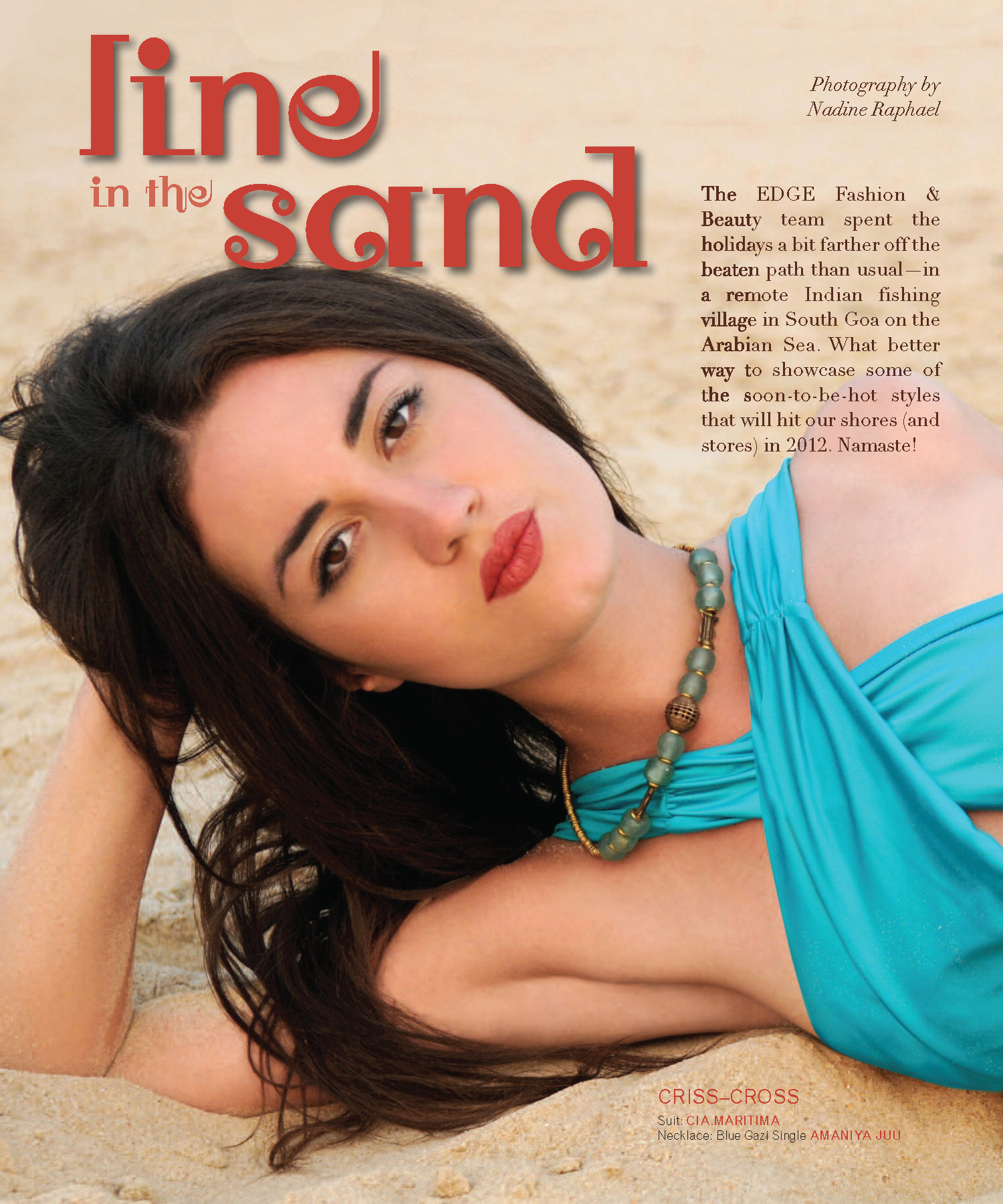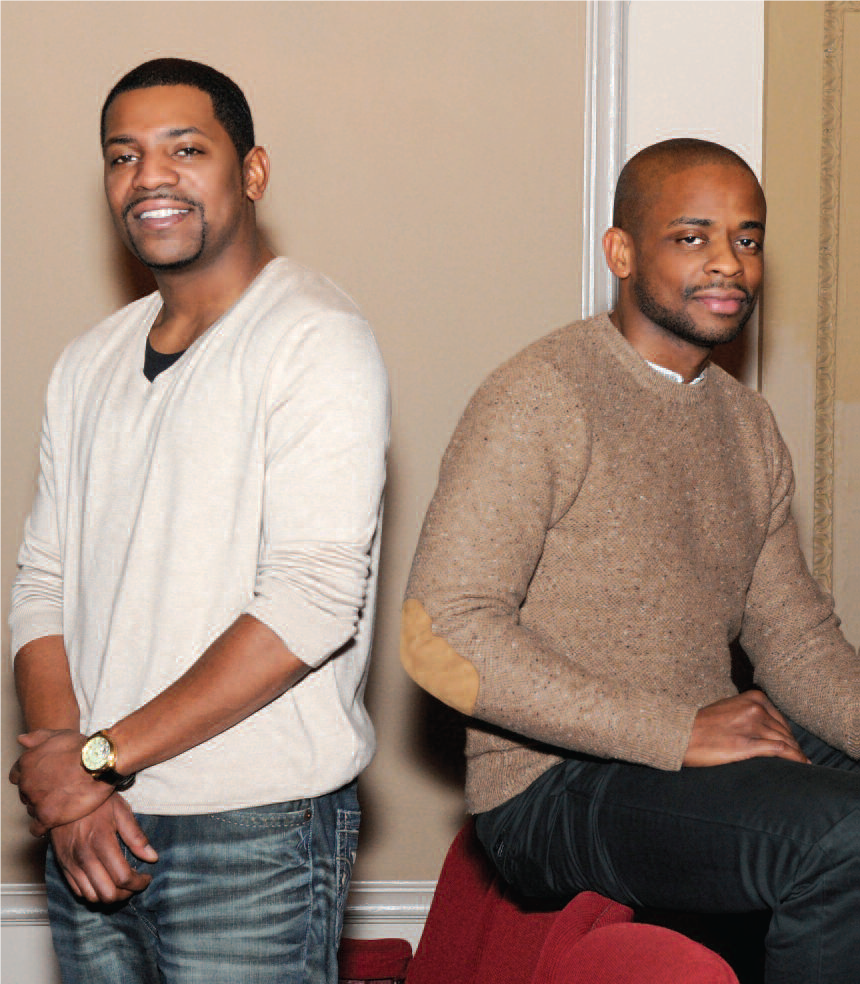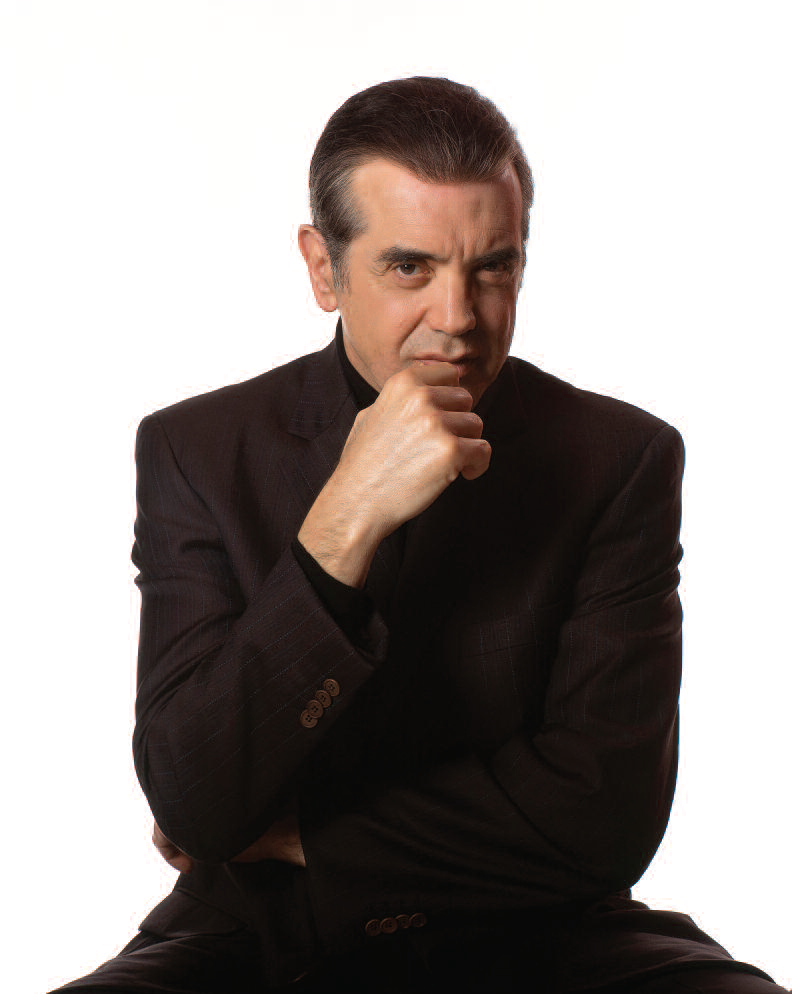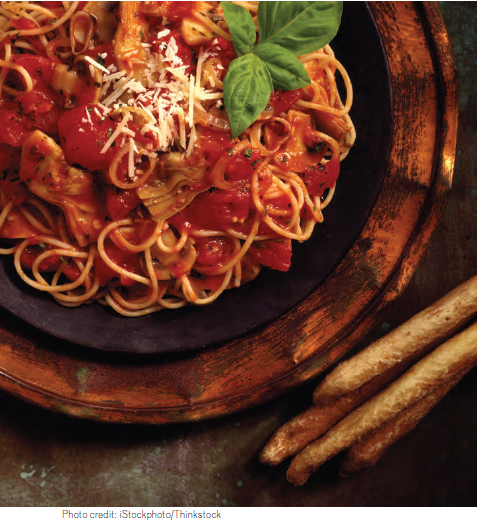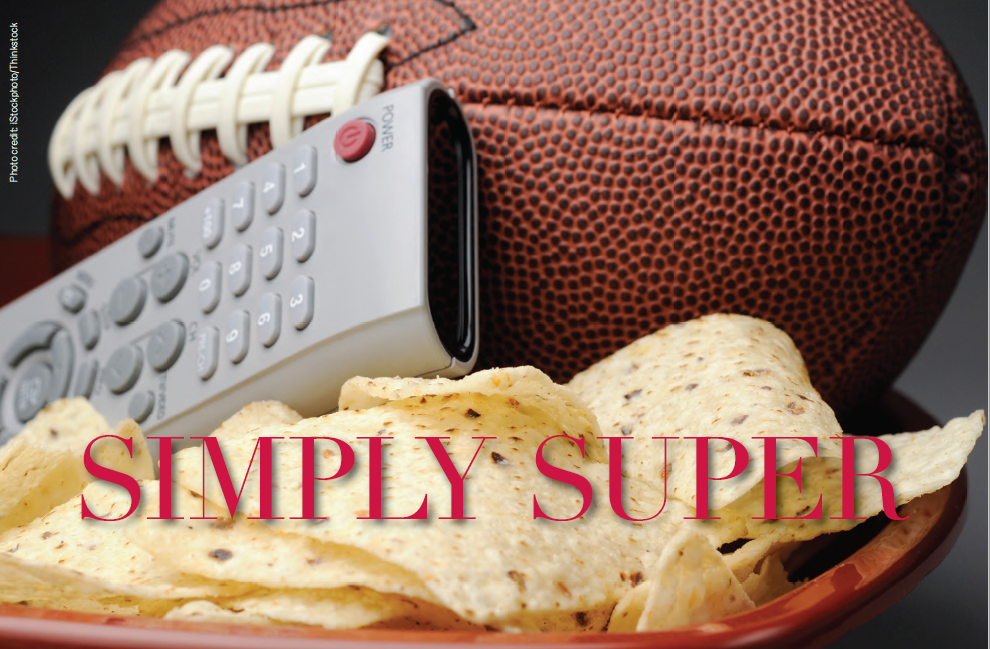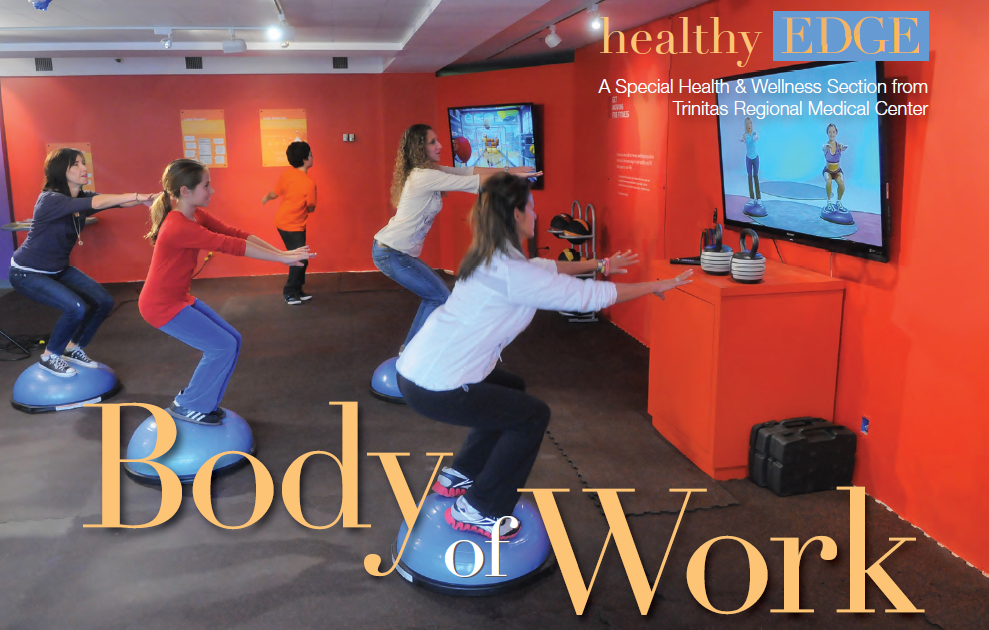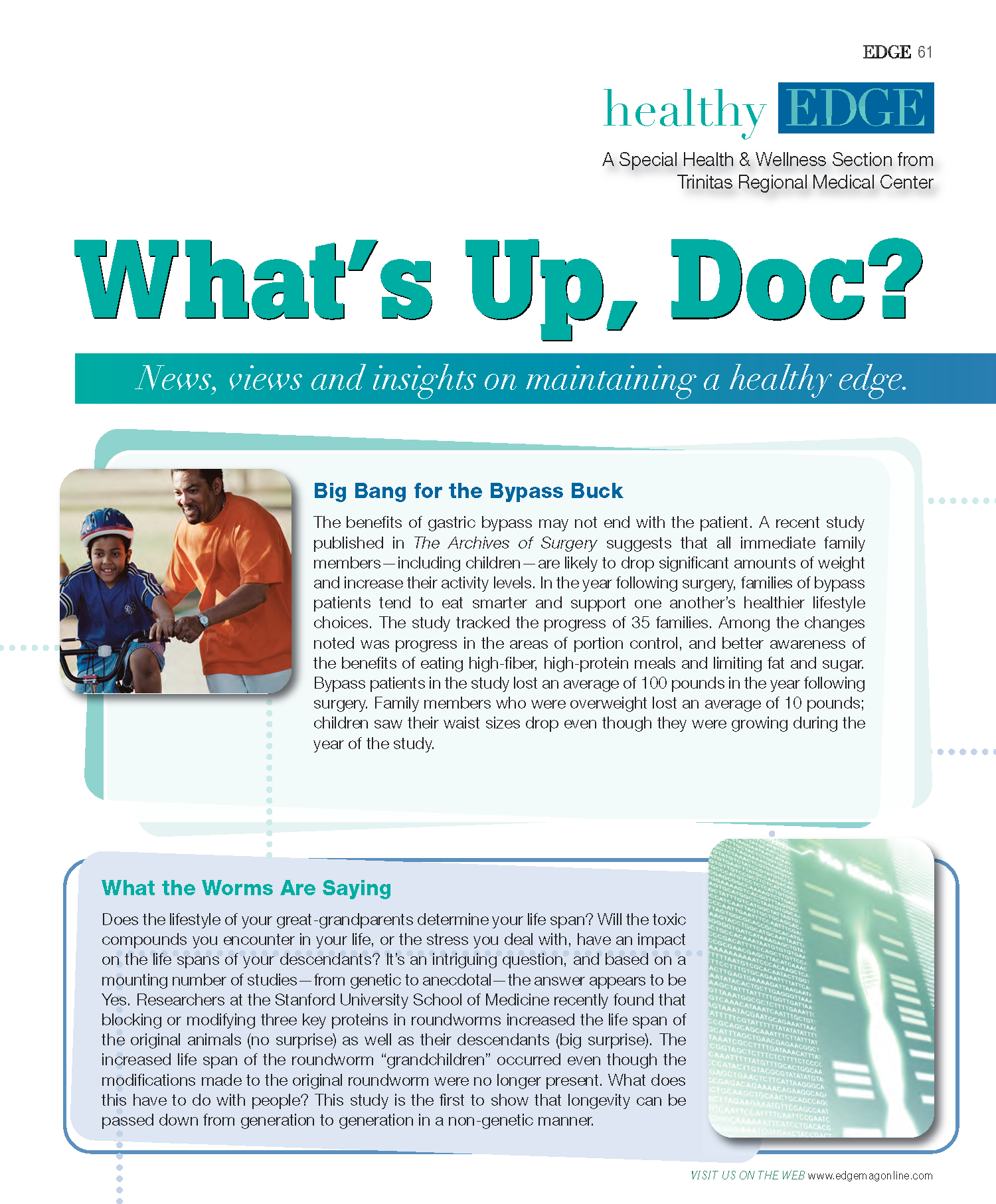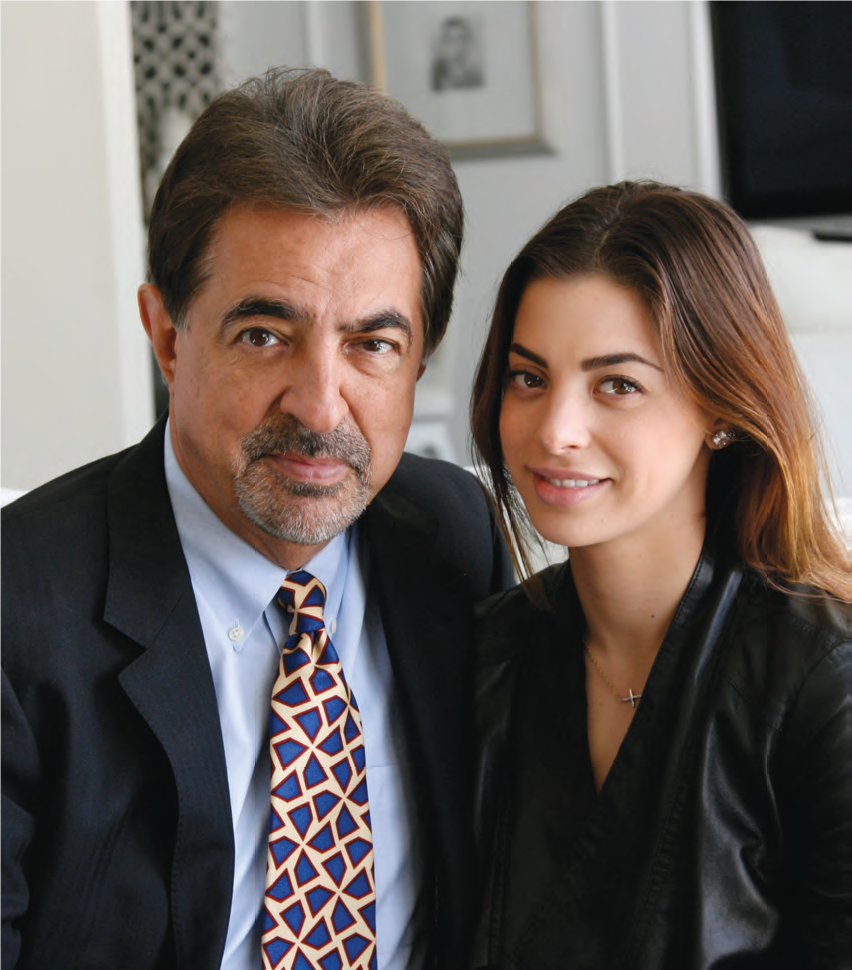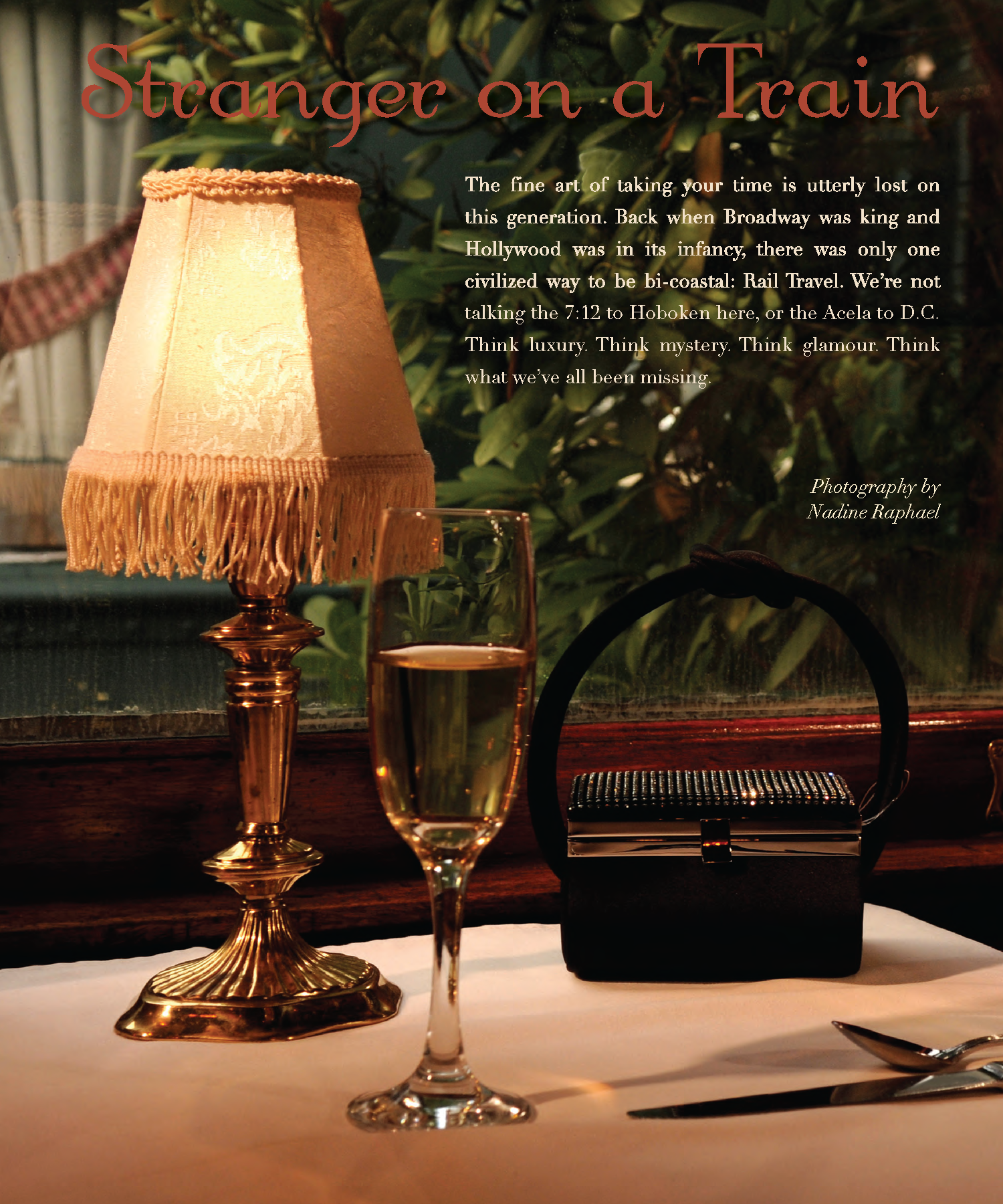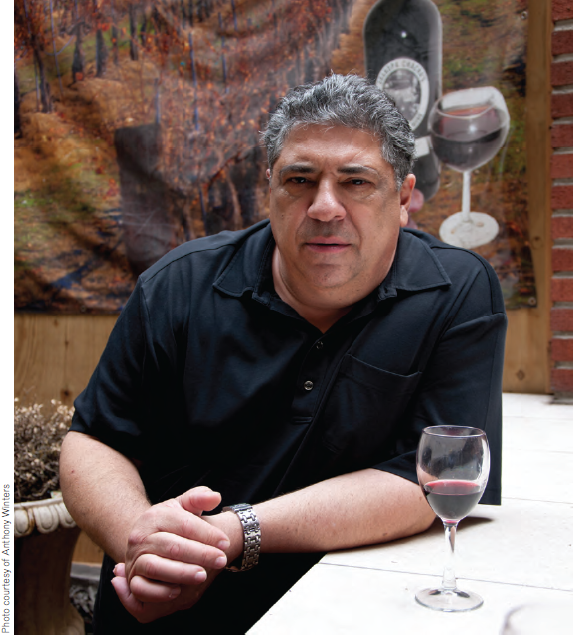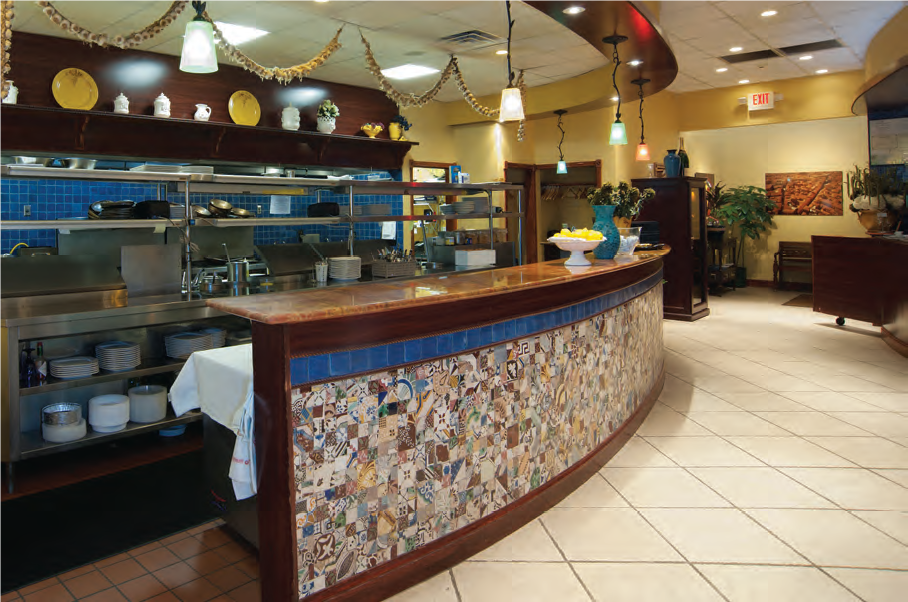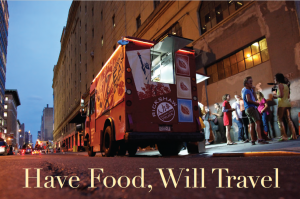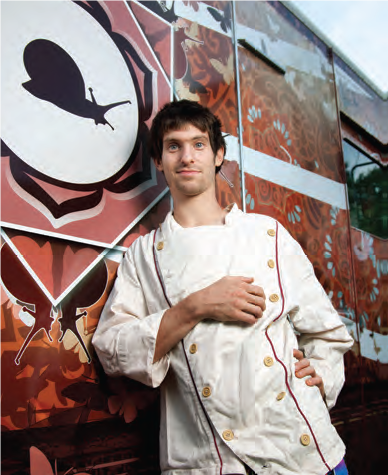






Everyone in New Jersey thinks they can run an Italian restaurant. I don’t think I want to.
Being part of an Italian restaurant is all I’ve ever known. I was born into a generational, family owned business that has been operating for more than fifty years. My grandfather’s dream was my playpen. Literally. Warm smiles were usually accompanied by a pignoli cookie or a cannoli. The servers were like aunts, uncles and cousins. What a fabulous and affectionate way to spend my childhood. It was not a life of privilege in the conventional sense. I wasn’t born with a silver spoon in my mouth. But a wooden one suited me just fine. Of course, the reality of the business eventually climbs into your life. My childhood Candyland was a living, breathing, hectic restaurant. And it wasn’t always sunshine and dreams. My first real job in the restaurant took place at the tender age of 13. Twice a week, for a total of four hours, I labored in the bakery. That time was primarily spent pouting, standing along the wall, brushing crumbs onto the floor and trying to look busy whenever my parents walked in. All the while, the actual workers were glaring at me. I wasn’t helping. I was in their way. Other kids I knew got grounded when they did something wrong. I was forced to help the hostess on busy Saturday nights. I did more moping than greeting. Ironically, when I look back, I would have to say hostessing was my favorite duty. It required the least amount of actual movement or labor, and I got to stand there looking all dolled-up for a few hours. Working in the bakery would come in second, since all I really had to do was fold cake boxes, weigh pastries, hand customers breads or pizzas,
and assemble cookie trays (so that one extra would land in my mouth). My least favorite (and current) duty is waitressing. Although it is the highest-paying job in the restaurant, at the end of a shift I am covered with grease and alcohol, my head is filled with customers’ complaints and I am dog tired. Being a waitress is really hard work. This is compounded by my natural talent for messing up orders, dropping plates and spilling drinks on patrons. Once I was blind-sided by a negative review of my service after I thought I had done an amazing job with a table. The customers’ actions and generous gratuity seemed to confirm this, yet they smack-talked me on the way out to my manager. That was an especially low blow to my ego. Although being part of a restaurant family has its occasional perks, family members tend to get the short end of the stick compared to the employees, particularly when it comes to the more unpleasant jobs.
There have been numerous instances where I’ve had to get down and dirty. Really dirty. When there’s a clog in the restroom, it always falls to a family member because we can’t say, “I quit!” Also, if I have an amazing date on a Saturday night, or maybe I’m just having one of those days, can I call in and say I’m a no-show tonight? Fugghetaboutit. Can they call me in on my day off because someone else left them hanging? Absolutely. So here I am, a struggling writer with a handful of clippings and a college diploma, looking to get out of the restaurant business as soon as I can afford to. It’s not a decision I came to easily. To take over the family business and continue the Piancone legacy would put a colossal beam on my father’s and late grandfather’s faces—especially since I am an only child and the oldest of seven cousins. Although pride would be coursing through their veins, my family members completely support and understand my need to pursue the career of my choosing. And needless to say, without the help from my family and the restaurant, I would not have been able to receive my undergraduate degree, or be able to put money aside for graduate school. Of course, this is New Jersey, so there’s always someone out there dying to run an Italian restaurant. If that’s you, my advice is to involve your extended family—but also to go in with your eyes wide open. You will need a family that is at least semi-stable, and always ready to man-up and hold down the fort. For what it’s worth, here are some additional words of wisdom:
Treat Family & Workplace Like Church & State. No one wants to talk or think about work after they’ve made it back to the sanctuary of the home. Imagine being overworked and exhausted and then having someone—I won’t mention any names, Mom—asking an endless series of rapid-fire questions. Was it busy? How much money did you make? What’s your schedule? How did the food look? Were there a lot of people at the bar? By the same token, everyone needs to leave work baggage at the door. This is definitely easier said than done. It is also inevitable that your personal life will clash with your work life. Expect it, but don’t invite it. Bottom line? Separate home and work problems. Long-term it’s the only successful route to take.
Respect the Pecking Order. The boss is the boss, the chef is the chef, and family members need to fit in to make a place run smoothly. As the boss’s daughter, I got treated differently. The chefs were nice to me even though, as a rule, they don’t have such a peachy demeanor. On the flip-side, no one wants to include you in small talk. It’s amazing how kitchen conversations suddenly end when I pop my head in and say, “What’s up, guys?”
Don’t Take It Personally. If a customer is unhappy with the food or gripes about the service, chances are he or she is complaining about a family member. Let it go. Stay calm and respectful, even if your stomach is tied in knots. Everyone has an off day, including Mom and Dad. In my case, there’s an added twist since my boyfriend works in our restaurant. When a customer calls him a cutie pie, I need to tell myself servers and patrons are always flirting. Again and again and again. All kidding aside, the Piancone family has experienced business and personal success due to our genuine love and passion for the restaurant and one another. Unlike a corporate work environment, our staff is made up of handpicked prodigies that we know truly care about the well-being of the restaurant because they are our best friends. Our church and state may continuously clash, and a few customers may give us grief, but at the end of a long night, we know we’ll come together and share a glass of wine. Which, believe me, beats the heck out of those pignoli cookies.
Editor’s Note: Johnny Piancone (johnnypiancone.com) is located on Broadway in Long Branch. Francesca’s grandfather and his brother started in Bradley Beach in the 1950s. Francesca graduated from Lynn University in Florida. She wrote for Gold Coast magazine before joining the EDGE family.
The Cold, Hard Fact
New Jersey’s number-one export is college-bound seniors. During each application period, the nation’s top colleges are flooded with applications from the Garden State. It’s a numbers game that works against our kids. However, if you do a little homework, there are definitely ways to make the numbers start working for you. So with the dark winter of college acceptance letter anticipation upon us, let’s look back at the 2011 application period and see what it has to teach next year’s juniors and seniors. First things first. For the mournful applicants who threw their hats in the Early Decision ring at Ivies such as Brown University—which accepted only 900 of the 2,900 applications—ED now stands for Early Disappointment. Ditto Northeastern, which deferred an inordinate amount of highly qualified Garden Staters. The story was the same in one popular school after another. Indeed, many of our young and talented “intellectual-istas” are now pacing the library aisles hoping that fat envelope shows up in April…and wondering what went wrong. What went wrong is that they all chased after the same hot colleges, essentially forcing the hands of admissions officers to say No. Geographical diversity is a high priority at most top schools. Translation: we can only take so many kids from New Jersey. How do you swing those odds in your favor? That process starts during the critical first steps in the college search and application process.

Photo credit: iStockphoto/Thinkstock
MANAGING EXPECTATIONS In order to have successful outcomes, an ounce of expectation management is worth any of those one-pound college guides you’ll be buying at the local Barnes & Noble. Understand where your college-bound child fits into the overall admissions picture. For instance, while GPA is a healthy indicator of a student’s success in college, a 3.0 at The Lawrenceville School is quite different than a 3.0 at nearby Trenton Central High School—with due respect to both. Standardized test scores are also useful in helping a student (and more importantly his or her parents) determine whether or not the student is likely to be admitted or likely to be rejected by a given college. Beyond those quantitative indicators, one must acknowledge that college-admission decisions can also turn on relationships. In addition to an “in” or connection at a school, however, students must also demonstrate a knowledge of the culture and mission of that college—and articulate that interest throughout the application. To do so, successful applicants must really know the colleges to which they are applying. And if that school is a “hot” school, well, they really need to bring their A-Game to the application.
IDENTIFYING A HOT COLLEGE Long before work begins on applications, you can start creating a wish list of schools. That list will almost certainly be populated by a number of hot colleges. That’s fine and that’s fun, but look at those schools and ask yourself, how many of them were popular five or ten or fifteen years ago? Where I’m going with this is that there are a lot of schools right now primed to “join” the hot list. Your job is to identify them before everyone else does. Beating the competition to a hot college is much like picking a stock. First, observe how the school performs over a period of time. Frankly, this is one of the major reasons families come to people in my business. Educational consultants visit numerous college campuses, read The Chronicle of Higher Education and other pertinent periodicals, attend symposia and present at conferences, and nurture ethical relationships with admissions representatives—all on their clients’ behalf. Of course, you can “day-trade” and do the work yourself. Begin by identifying and tracking a college of interest. Some points to consider are: Has this school made a jump in rankings and/or is it rankings-aware? Has there been a recent shift in leadership? Are the current students and grads singing the school’s praises? How strong are the career services and what companies recruit on campus? This information isn’t always easy for a layperson to access or understand, but the more you amass, the better your results will be. One good publication that is literally the length of a church bulletin is the CollegeBound newsletter (collegeboundnews.com), which is very readable and provides real-time admission numbers. I tweet these bitesize stats daily.
NAMING NAMES Without specifically advocating these institutions as bestfits for any individual, here are a couple of examples of what I’m talking about. Ever heard of High Point University, in North Carolina? If not, you will. I have been following High Point for some time now. It has all the earmarks of a hot college due to the leadership of its president, a former CEO with a business-savvy approach to student satisfaction and success. The graduating senior entering just four years ago probably would not be accepted this year in the Early Action pool. Size, location and price-point make this college one to watch. Closer to home, I also like what I am seeing at Drexel University. It stands out among the growing number of colleges offering co-op opportunities. Co-op stands for “cooperative,” which is an option at some colleges that enables students to earn course credits for work experience in the form of approved internships (which are frequently paid!). This option is best suited toward pre-professional students who are actively preparing for a career in a specific field, learn-by-doing students, and students who want “a foot in the door.” An inordinately large number of students are hired by the firms at which they completed their co-ops. It’s not hard to see why schools offering co-op programs have seen their popularity and demand rise over the course of the past three years—while at the same time the precarious economy has called into question the value of the liberal arts education in favor of a skill- and career-based undergraduate education. Making industry connections and building up a résumé all appear to be de rigeur at this juncture, but as a purist, I beg to differ that the liberal arts and sciences are passé. In favor of this argument, take Bucknell University. Tucked away in Western Pennsylvania, this Division I college has grown extremely selective in its admissions decisions over that past decade. The emphasis on interdisciplinary study and engaged learning is helping Bucknell produce superlative leaders and self-starters.

Photo credit: iStockphoto/Thinkstock
DOLLARS AND SENSE As college costs skyrocket and family budgets tighten, the “default” pick for many students is the state school or community college. However, that is not necessarily where the higher-education bargains are. Indeed, the changing economy has created some eye-opening options—and potentially an entirely new class of hot colleges. Parents of 10th and 11th grade students at this juncture may want to consider the fact that most students at independent institutions pay less than the published tuition price. According to College Board’s “Trends in College Pricing,” the average student paid $17,000 less than the sticker price at independent colleges and universities in the U.S. in 2010-2011. How is that possible? Federal grant aid for students at state schools is about $3 billion a year. Meanwhile, institutional grants—the free money given to students by the colleges they attend—is around $20 billion! So opting for the state university or community college without exploring the estimated cost after Gift Aid could cost you in the long run. Gift Aid is free money for college that students do not have to pay back. It comes in the form of tuition discounts off the sticker price for attractive applicants. A strong academic profile and high-test scores—which will in turn boost a college’s rankings—are two reasons why colleges would offer Gift Aid to an applicant. By the way, as of last December a mandatory net price calculator must appear on all college web sites. This is a groundbreaking change intended to help families get an early read on the true cost of college. Though each site’s calculator will vary, some will calculate Gift Aid. The bottom line is that the college application process can be a messy one, but it’s definitely manageable. Of the many things that are crucial to keep in mind, perhaps the most important is that college is not a one-size-fits-all prospect. The right school, hot or not, is out there for your collegebound son or daughter. The more effort you put into identifying that school, the better your chances for a positive outcome.
Editor’s Note: When Erin is not authoring articles, she runs Avery Educational Resources (averyeducation.com). She also does pro bono work with children who lost parents on 9/11. A Division I varsity athlete and a competitive Irish step dancer, she holds two Master’s degrees from Oxford and Yale Universities, respectively.
Anyone who questions whether acting is a craft needs to spend a little time with the cast of a play like Stick Fly, which opened to rave reviews this past winter at the Cort Theatre on 48th Street. Produced by Alicia Keys and directed by Kenny Leon, Lydia Diamond’s engaging family drama explores themes of race and class through the story of an upper-class African-American family. While this may be unfamiliar territory for most Broadway theatergoers, the two male leads of Stick Fly are instantly recognizable. Mekhi Phifer (ER) and Dulé Hill (The West Wing and Psych) rank among the most beloved and talented ensemble television actors of our time. Hill is an old hand where Broadway is concerned, while for Phifer Stick Fly marks his debut. EDGE Assignments Editor Zack Burgess met with the co-stars before a performance at the Cort over the holidays. Three-way Q&A’s can be tricky—especially with so much ground to cover—but as usual, Zack just pointed his subjects in the right direction and they took it from there.
EDGE: Did either of you have a professional relationship with Alicia Keys prior to this production of Stick Fly? Dulé Hill: No. But I have always been a fan of hers. Who’s not a fan of hers? Mekhi Phifer: I knew her, but of course not to the level of our friendship since this project got started.
DH: I had done a version of Stick Fly about five years ago in L.A. It was a staged reading with mikes. It kind of reminded me of old-school radio. It was fun. I hadn’t thought about it since then, and then I got a call back in the summertime to do a project. I knew they had an offer out to Mekhi, which really piqued my interest. Once I was told the name of the play, I said I’m in. Alicia’s involvement was the icing on the cake.
EDGE: You both have done lots of television and film work so you have a good background in terms of shared experience. The exception is probably that Dulé has spent time on the Broadway stage. Mekhi, how has Dulé helped you adjust to performing on stage?
MP: Dulé has done Broadway four times. I’ve never done a play, so I’ve asked him a lot of questions. It’s always helpful to be surrounded by people who are veterans and who are good at what they do—who know what is entailed in making this thing work. Being able to go to Dulé was very helpful for me to get acclimated to this environment.
DH: Remember that the other pieces have mostly been musicals. This is only the second produced play that I have done. So it’s still kind of a new world for me. I’m not going to be putting on any tap shoes or singing.
EDGE: Dulé, what did you see as Mekhi’s immediate strengths in terms of stagework when you guys started rehearsals back in the fall?
DH: It comes down to being a brilliant actor. He brings it every time. That’s the case whether he’s on ER playing Dr. Pratt or the star of Paid In Full, coming on Psych or playing Flip in Stick Fly. That alone is it. Having those skills. There are things you have to do when you’re dealing with the stage versus film and television, and Mekhi took everything in, learned and adapted. He asked questions and processed information very quickly. You wouldn’t know that this is the first play he’s ever done. I really respect him for that.
EDGE: Dulé, are there any parallels between the LeVay Family in Stick Fly and your own experience growing up in New Jersey?
DH: I grew up in a middle-class family, although I don’t think we had anywhere near the type of money of the LeVays. But I definitely relate to the LeVays’ dysfunction. I have a great family, but we have our level of dysfunction, too. There are things we don’t talk about. We don’t always address issues when we should and they end up simmering underneath and then exposing themselves in other areas.
EDGE: What about similarities to your character, Spoon?
DH: Spoon is trying to figure out where he wants to go in life. And that is foreign to me because I started doing theatre at the age of ten, and started tap-dancing when I was three. I’ve always been on a journey of self-discovery and owning who I am as Dulé—not trying to fit into the mold of what other people think I should be. Spoon doesn’t own his vision. He starts to figure it out during the play, but in a way his family never supported him or gave him the opportunity to really find out what he wanted to do. I’m very thankful that my parents supported me, exposed me to new experiences and let me find where I want to go in life.
EDGE: Is that what Stick Fly is about?
DH: It’s about family dysfunction, self-identity…and daddy issues.
EDGE: Daddy issues in what respect?
DH: The idea that, when you’re a child, your father is perfect. For instance, I love my dad to death, but growing up there’s this issue of trying to fit into the mold of who you think you should be because of your father. Then one day you realize that your father is a man just like you. He has his own faults and Achilles’ Heel.
MP: My character, Flip, emulates his father. He’s a doctor, like his dad. He’s just living life. He’s off the cuff. Flip has what is seemingly a closer relationship with his father than the one Spoon has. But I think what makes Dulé’s character stronger than mine in certain respects is that Flip took the more accepted route by becoming a doctor.
EDGE: What was your family background like, Mekhi?
MP: I grew up in a single-parent home and never met my Dad. At the same time, my mother was a schoolteacher, a dancer and a choreographer. She always stressed academics, but she was also about the arts. There was never one way to do something. She favored an obtuse way of thinking versus an acute way of thinking. So my mom wanted me to have great grades and she looked over my homework. But she was always supportive of the arts. So when I was a kid and I would do little talent shows, or rap in freestyle and battles, she was always very supportive.
EDGE: What nuggets of wisdom have you guys picked up from your co-stars over the years?
DH: We’ve worked with phenomal co-stars.
MP: I agree, we’ve both been blessed to work with some dynamite co-stars.
DH: On The West Wing, Martin Sheen used to say to me, “It’s got to cost you something. If it doesn’t cost you something, then it’s meaningless.” Whether it’s the journey of the character or you as an individual, you really have to put yourself into it. Something—time, energy, whatever— has to be sacrificed if you’re going to have a successful career. For example, if I’m hanging out all night partying and then try to come on stage the next day, it’s just not going to work. You have to make choices and say, “This is where I want to go. This is what I want to do.” That always stuck with me. What also struck me about Martin was his humanity, how personal and gracious he was with everybody. I try to take that part of him and apply it to my own life.
MP: The first piece of advice that really stuck with me came while I was doing my second film, Tuskegee Airmen. Laurence Fishburne told me then that “less is more”— especially when you’re dealing with film and television. Another piece of advice I got was from Bill Cosby. He said somebody had asked him what was the key to success, and he said he didn’t know, but he did know the key to being unsuccessful, and that’s trying to please everybody. Those two poignant statements have stuck with me throughout my career.
EDGE: From Martin Sheen and Laurence Fishburne we move on to Jon Lovitz…Mekhi, what do you take away from a crazy comedy like High School High?
MP: Jon Lovitz was wonderful. We were all young in that movie and I always remember him being so nice. He was extremely successful at that point, just coming off of doing SNL. That was early in my career and it was a little bit of a whirlwind for me. But Jon’s one of those guys that will stop you on the street and talk to you, and after awhile you’ll be like, All right Jon, enough is enough. Enough jokes. I’ve got to go. So like Dulé said about Martin, yeah be successful, but be gracious as well. Live life and get to know more people.
EDGE: Dulé, you got to know Wesley Snipes working together on Sugar Hill. What insights did he give you as an actor?
DH: There was one thing that Wesley told me that stuck with me. I had just gotten to L.A. and it was right before I got The West Wing. I was auditioning for stuff and I wasn’t getting the roles, the scripts weren’t very good, and I was going to get dropped by my agent. I ran into Wesley one day and he said, “If there’s always one way, there’s always another.” I asked him what he meant by that and he explained that if you see a bunch of people going up a hill and falling back and not making it through, then try to look on the other side. There’s not just one way to get to your destination. I don’t know what he meant for me to receive from that, but it always stuck with me. From then on I’ve always looked for different angles on how I approach a character, and my career.
EDGE: I am curious how the involvement of a major musical personality changes the culture of a movie or a TV show or a stage production. For instance, Mekhi, when you worked with Eminem on 8 Mile, was that a very different experience than the other films you’ve done?
MP: It was great. Pure fun. I’m 26, 27, we’re in Detroit, Eminem is at the apex of his career. We had a month of rehearsals so that Eminem could get dialed in. We partied hard and it was fun. It was a great experience working with a director like Curtis Hanson and all these actors who were relatively unknown at the time. We had a blast. What I loved about Curtis was that he trusted us. Even when we were doing the battles—that stuff was not scripted. And the people in Detroit were great. What made those battle scenes real is that those people were real people. They were not day-to-day extras, they were real people from the neighborhood.
EDGE: Every successful actor has that role that he almost got, but it went to someone else. So tell me, each of you, what was the “one that got away”?
DH: That’s a tricky question, because if it got away then it was never really mine. There are roles throughout my career that I wanted, but I’m very happy for the actors who got them. One was Savion Glover’s role in Tap, because I’m a tap dancer. To work with Gregory Hines, Steve Condos, Harold Nichols, Jimmy Slyde and Sammy Davis, it really hurt when I didn’t get it. I just wanted to be in that space with those great actors. A lot of those guys started passing on right after that. Antwone Fisher was another role I really wanted. I would love to have shared the screen with Denzel Washington for that amount of time. Derek Luke got the role and Derek’s a good friend of mine. It really exploded his career. I was happy for the actors who got those parts, but I would be lying if I said I hadn’t wanted those roles.
MP: Right after I did Clockers with Spike Lee, I auditioned for Dead Presidents. I was right down to the wire for the role of Anthony and they decided to go with Larenz Tate, which was fine because Larenz is a friend of mine. They were shooting in New York, it took place in the Bronx, and the Hughes brothers were just riding high off Menace II Society. I remember meeting with the casting director, who thought they were going to give me the part. But I guess the Hughes brothers already had a relationship with Larenz—who had stolen the show in Menace II Society. I guess they figured We’ll ride with him.
EDGE: Have you ever walked out of an audition thinking you’d messed it up?
DH: Going back to Antwone Fisher, I got a chance to read with Denzel. Now normally after I read a script, I don’t usually get caught up in the things that are in parentheses— words like ANGRY or UPSET. I leave that alone and go with my own journey. For some reason in that particular situation, I saw the word ANGRY sticking out. So when I’m in the room and it’s me with Denzel, that word kept popping into my head. So I’m reading and I’m being angry. The first thing Denzel said to me was, “Why you so angry?”
EDGE: But your career survived.
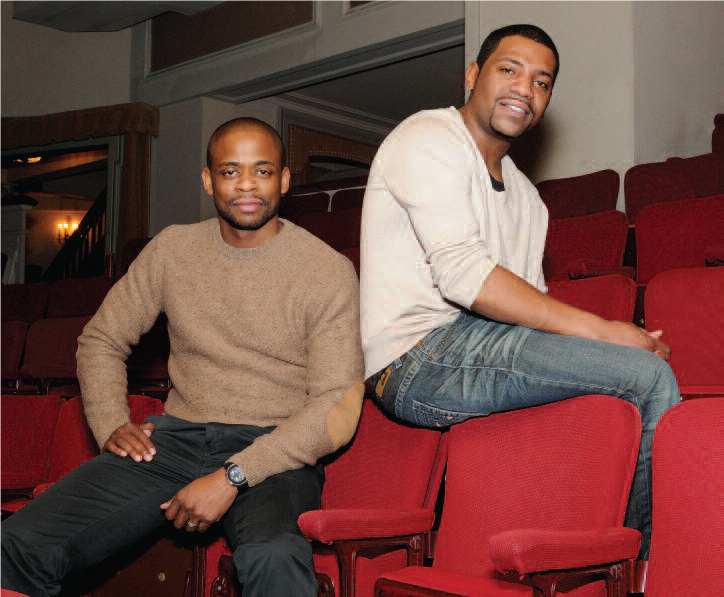
Photo courtesy of Nadine Raphael
DH: It did. So to all the people out there, I say just because you mess up on one thing doesn’t mean it’s the end of the world.
EDGE: Back to Stick Fly—Dulé, how does this cast compare to some of the others you’ve worked with?
DH: One of the perks of being in this business is just the camaraderie that exists with the people we work with. That’s what makes a show like Psych successful. These people are really good at what they do. And they also happen to be really nice people—people that you want to hang with and have drinks with later. Look at Stick Fly. When you work with actors like Ruben Santiago-Hudson, Tracie Thoms, Rosie Benton—they challenge you just to step up to another level. Ruben is a bona fide professional veteran, Tony Award winner and dynamic actor. You can’t half-step it with Ruben. It’s not going to happen. They’re all phenomenal actors. Then you get blessed to be in a situation where you’re seeing someone like Condola Rashad—someone who is already great, but her career is just getting started. I’m really honored to be on the stage with her. She’s knocking it out of the park now, but in ten, fifteen years I truly believe I will be saying that I was a part of her journey to greatness.
EDGE: What does your director, Kenny Leon, bring to the show, and how might someone in the audience at Stick Fly experience that?
MP: Kenny brings a realism to it. I’ve been to many Broadway shows and the worst thing in the world is to sit there and you’re bored out of your mind. You start fidgeting, you start falling asleep. Kenny not only stresses pace, but telling a story and being good at what you do as an actor. A good analogy would be a dog race. We, the actors, are the rabbit. The audience is the dog. We want them to come up to our speed, and I think we succeed. Doing a play is a totally different machine when it comes to directing. I love Kenny’s direction.
DH: I have to say that most of the directors I have had a chance to work with have been brilliant. But there are things about Kenny that remind me of George Wolf, the director of Bring in ‘da Noise, Bring in ‘da Funk. They are both very specific about every little detail. Everything we’re doing on stage in Stick Fly is meant to draw the audience’s attention to where Kenny wants it to be. That’s cool, because sometimes as an actor you forget those things.
Editor’s Note: Zack Burgess writes about politics, sports and culture for a variety of publications and web sites. You can read his work at zackburgess.com.
As a performer and storyteller, Chazz Palminteri holds a special place in American popular culture. Coming of age in the Bronx during the 1950s, he was surrounded by the neighborhood characters and themes that would one day populate A Bronx Tale, the beloved one-man show and film that catapulted him to stardom. Palminteri’s creative journey has been marked by artistic, critical and financial successes—both as an actor and writer (and, yes, even as a restaurateur). Yet as EDGE’s Assignments Editor Tracey Smith discovered, as far as Palminteri has come, his comfort zone is still that stoop at 187th and Belmont. All these years later, for an observer of the human condition, it’s still the best seat in the house.
EDGE: The apocryphal story about A Bronx Tale is that you turned down a million dollars for the movie rights because you wanted to write the screenplay and play Sonny yourself. True?
CP: Yes, it is absolutely true that I turned down a million dollars. I wrote Bronx Tale: A One Man Show to showcase myself and show people that I could play eighteen different characters. I wanted to play Sonny. I wanted to write the screenplay. It’s about my life and I didn’t want anybody from Hollywood taking it and doctoring it up, sanitizing it or whitewashing it. I wanted it to be real, you know, and truthful. They felt they couldn’t make a movie without a star. I wanted people to see what I could do. So I just said no.
EDGE: That’s commitment.
CP: Everybody in Hollywood went crazy. The first offer was $250,000, the next offer was $500,000. I just said no. Don’t forget now Tracey, I was running out of money. I was down to my last $200. Actually $187.00 to be exact. I kept saying no and then they said $1,000,000—and I said no again.
EDGE: Enter Robert DeNiro.
CP: Yes, a week later Robert DeNiro walked into the theater and saw it, loved it and came backstage. He told me how much he thought it was great and how great I was, and said, “Look, you’d be great as Sonny. And you should write the screenplay, because it’s about your life. You should be Sonny and it’ll be real and I’ll make it real. You make it with me, I’ll make it come to life, I’ll play Lorenzo, your father, and I’ll direct it and we can be partners. I give you my word.” I shook his hand, and the rest, as they say, is history.
EDGE: You and DeNiro became good friends.
CP: Bob is a really good friend. We’ve been friends for 25 years. We’ve done several films together, and been involved in many projects. He’s the best. He wants everything right, you know, and he doesn’t care how long it takes. He’s a perfectionist, as am I. That’s why we get along so well. We have great chemistry.
EDGE: How would you rate him as a director?
CP: I’ve always said that the reason why A Bronx Tale turned out so good is because I had a great director who wanted to make it “life.” A bad director can spoil a great script, and a good director can make a bad script into a movie. But a great director can make a really good script fly, and that’s what Bob did. I wrote a really good script. Really good. And Robert DeNiro made it fly. He made it real.
EDGE: Which parts of the story were autobiographical?
CP: I would say a good 80 to 85 percent of the movie is autobiographical. It really stems from when I was nine years old sitting on the stoop and I saw this man kill another man right in front of me. Just like they did in the movie, exactly the same. My father came down and grabbed me upstairs, and then the cops came. The reality is I never went down and did a lineup. I just said I didn’t see anything, and that was it. Also befriending the wiseguys when I was a kid, throwing the dice for them, going to get things for them—that’s all true. Also my dad was a bus driver. He worked right off of 187th street. My mother used to be out the window all the time. I fell in love in with a black girl at the age of 17. Some of the guys I knew died in a racial attack with some black youths. The majority is true. But I had to blend it all in the same timeframe.
EDGE: There are a lot of complex themes in A Bronx Tale. What affects people most deeply? What aspect of the story do they identify with the most?
CP: I wanted to talk about the working man and what my dad instilled in me. Yet as good as my father was, he had some qualities that he had to change. And regardless of how much of a bad guy Sonny was, people loved him. They were sad when he died. Taking the best of Sonny and the best of my father and becoming this man who I am today—that’s what resonates most with everybody. Also, I think because it’s not about black and white or good versus evil, people just love the story. They identify with the different characters.
EDGE: Out of curiosity, how does one play 18 characters in a one-man show?
CP: A lot of practice and a lot of rehearsals. But God has given me the gift and somehow I’ve mastered it.
EDGE: What prompted you to write the one-man show?
CP: Desperation. It was desperation. I was doing a lot of small roles and couldn’t break into the higher echelon. I thought, if you won’t give me a great part, I’ll write one myself and show you how good I am. I’ll make my own story, and make you listen to me.
EDGE: Your next role after A Bronx Tale was Cheech in Bullets Over Broadway. You played a mob heavy with a genius for writing dialogue…and were nominated for an Academy Award. Was that character in the original script, or did it evolve after you got the part?

Photo credit: Joan Marcus
CP: Woody Allen always tells people, “When I found Chazz Palminteri, he was born to play the part.” It was written that way. When I first read it I was like “Holy smokes, this is amazing!” I couldn’t get over it.
EDGE: After these two films, how did life change for Chazz Palminteri?
CP: Oh God! More money! Much more money! And more opportunities, oh yeah! I exploded out of the box!
EDGE: Of the 50-plus films you’ve done since then, which ones should I go back and watch again to see you in a really interesting performance?
CP: Okay, let’s see, Hurlyburly is one. A Guide to Recognize Your Saints is one definitely. And I would say Mighty Fine, the one I just did with Andie McDowell, is a great one. Mulholland Falls is another one.
EDGE: You have a recurring role as Shorty on the hit series Modern Family.
CP: Modern Family is a great show, I love the people. They write me in as often as they can and I return. They’re like family, I truly enjoy working with the cast. I play Jay’s longtime best friend. It is just hilarious, a great show.
EDGE: Okay now to the serious stuff. The Yankees. What happened in the playoffs?
CP: Well, you know, they just didn’t win. It’s that simple. We won 97 games during the regular season. I never liked five games as a playoff format. I think everything should be seven games. That’s how you can tell who the best team is.
EDGE: You are playing Babe Ruth in the new movie Henry & Me. How great was that?
CP: That was great. Anything to do with the Yankees is not bad. I have always loved sports. My father used to take me to the games at Yankee Stadium. I loved Mickey Mantle back in those days and collected his baseball cards. I love the Giants, the Rangers.
EDGE: I read that John Franco was one of the producers of Henry & Me. Were you okay working for a Met?
CP: That didn’t bother me. I’m not rooting for his baseball team, but that didn’t bother me at all. John Franco is a very nice guy.
EDGE: So when is the long-awaited Chazz Palminteri autobiography coming out?
CP: I write screenplays and I write plays, but not a book yet. It’s just not time. I get my point of view out in my movies or my plays. My new four-character play, Human, should be out in 2012. I’m very excited about that. Maybe when I have more time and I’m older, I’ll sit down and write a book about my life.
EDGE: You are performing A Bronx Tale at the Mirage in Las Vegas this March. This past summer, you had a nice run in Atlantic City. Having performed this play in various places, have you noticed any regional differences in the way you relate to the audience—or the way they relate to you?
CP: I thought I was going to see that. But it’s the same thing everywhere. No difference from region to region. I can’t explain it. What I find flattering and a little strange, though, is how certain lines from A Bronx Tale have seeped into the dialogue and culture.
EDGE: How so?
CP: Once, I got on a plane, and as soon as the door closed, the pilot said, “Well, ladies and gentlemen, now you’se can’t leave.”
EDGE: Sonny’s line from the scene where the wiseguys lock the door at the bar and work over the bikers!
CP: Right. I laughed. I was like, Wow!
‘The ricotta-marinara blush sauce is crazy-good, its rich cheesey soul tempered by the acidity of tomatoes. Get it over a sturdy pasta that can stand up to the sauce.’
Should you be worried you’ve actually come to the right place, the voice – The Voice – of Frank Sinatra will reassure you that you have, that this duck-your head, watch-your-step, below-sea-level entrance is indeed the way, the only way, to enter the inner sanctum of Chef Vola’s. Frank is always singing at Chef Vola’s. 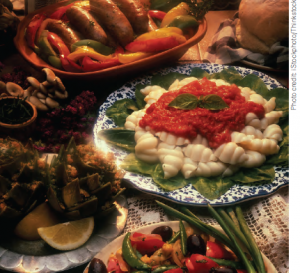 Frank, who legend has it wanted to be buried with a slice of owner Louise Esposito’s banana cream pie, who knew the secret behind the name of the world-renowned restaurant, and who just might be its unofficial mascot, invariably greets diners who descend into the basement and keeps crooning all night long. Those diners might be Jay-Z and Beyonce. They might be members of the cast of The Sopranos. They might be sports stars. They might be good old Jersey boy rock stars such as Jon Bon Jovi. You don’t believe these folks, plus heads of state and of Fortune 500 companies, hurdle the hoops of the reservation process to score a table in the cramped, cluttered, completely charismatic low-ceilinged, dimly lit dining spaces where vintage Italian nonna fare is served alongside a handful of improbable-sounding original Esposito dishes? They do.
Frank, who legend has it wanted to be buried with a slice of owner Louise Esposito’s banana cream pie, who knew the secret behind the name of the world-renowned restaurant, and who just might be its unofficial mascot, invariably greets diners who descend into the basement and keeps crooning all night long. Those diners might be Jay-Z and Beyonce. They might be members of the cast of The Sopranos. They might be sports stars. They might be good old Jersey boy rock stars such as Jon Bon Jovi. You don’t believe these folks, plus heads of state and of Fortune 500 companies, hurdle the hoops of the reservation process to score a table in the cramped, cluttered, completely charismatic low-ceilinged, dimly lit dining spaces where vintage Italian nonna fare is served alongside a handful of improbable-sounding original Esposito dishes? They do.
Check out Chef Vola’s walls of fame that bulge with bumper-to-bumper photos of Louise and her co-owner family members, husband Michael and sons Michael Jr. and Louis, as they snuggle with the familiar faces of those they’ve fed. Fancy-pants restaurants can’t claim the extent of the celebrity patronage of this 90-year-old BYOB a block from the Boardwalk and at the edge of a neighborhood sometimes described as a tad sketchy in Atlantic City. They fly in from L.A. They pit-stop from a finals match to a championship game. They hop-scotch from Munich via Philadelphia, renting a car and driving east on the Atlantic City Expressway. As did my dining neighbors the same night I marveled at the new additions to my old restaurant friend, which had gotten a bathroom upgrade and some extra seating since my last visit. (Oh, don’t think Chef Vola’s still isn’t cheek-to-jowl. You will, I promise, still be able to read the fine print on the wine bottles at the adjoining table and hear everything said.)
Two couples from Germany started their U.S. tour with a dinner at Chef Vola’s because, they revealed, friends who’d made a similar trek told them the food, the atmosphere—and what I translated as schtick—was the best anywhere. And you only have to drive from your home port somewhere in New Jersey. Chances are, once you do, you will again. You may well make reservations on your way out for your next birthday or anniversary. You will return for the cannellini and string bean salad scattered with cubes of sharp cheese and salami, a veal chop so large you will be glad you didn’t fly in because even the leftovers couldn’t fit in an airplane’s overhead compartment, pasta awash in a “blush” sauce that combines ricotta and marinara, and Louise Esposito’s pies, each of which—and there are a good couple dozen—have their own ardent legions of fans. I’ll throw my support behind the coconut-pecan ricotta pie, but we’ll discuss later. First, the hype surrounding Chef Vola’s is exaggerated. Yes, the phone number remains unlisted in a phone-book sense of listing numbers. But you have it here and you can find it if you have basic-level Internet skills. Second, you can get a reservation. As with many extremely popular restaurants, you simply have to plan ahead, call ahead and not expect a table at 8 on a Saturday night.
didn’t fly in because even the leftovers couldn’t fit in an airplane’s overhead compartment, pasta awash in a “blush” sauce that combines ricotta and marinara, and Louise Esposito’s pies, each of which—and there are a good couple dozen—have their own ardent legions of fans. I’ll throw my support behind the coconut-pecan ricotta pie, but we’ll discuss later. First, the hype surrounding Chef Vola’s is exaggerated. Yes, the phone number remains unlisted in a phone-book sense of listing numbers. But you have it here and you can find it if you have basic-level Internet skills. Second, you can get a reservation. As with many extremely popular restaurants, you simply have to plan ahead, call ahead and not expect a table at 8 on a Saturday night.
You don’t need to be blood relatives of the Espositos or routinely play to sold-out concerts in stadiums. Yes, it’s cash only, it’s not cheap and you must bring your own spirits. (Consider prosecco for starters and a red wine for entrées.) It is a bit hard to find on initial visit. Park in the lot in the shadow of the Tropicana and walk a block and a half north. That boardinghouse-style structure you see at an odd, almost dead end is Chef Vola’s. Don’t look up for the entrance, but look down and to the side farthest from the Atlantic Ocean. You got it, Bunky. Now you’ve got to get a salad, such as that double-bean number with creamy white cannellinis and crisp green-bean batons set off by the same elements as a classic chopped salad. Or, right for autumn, the toss of arugula with dabs of goat cheese, sweet-tart dried cranberries and a dressing much like a fig glaze, only thinner. Don’t go all hoggish on the plates delivered to your table: Share everything.
Chef Vola’s is where the you-getta-lot school of eating in Joisey was born. You’ll find prosciutto- and roasted red pepper-wrapped mozzarella served to half the diners around you. You’ll see crab cakes made from jumbo lump crab that defy the genre in pure size of lump. They’re simple and divine. Too many people, distracted by the sensationalism of the crab cakes, overlook the most rustic of dishes here, the veal sausages. Please don’t make this mistake. Channel your inner Italian grandma and get these links with their tangle of fried red and green peppers and onions. The second you’ll walk in the door, you’ll get a hankering for pasta, and you should not let this craving go unabated. The ricotta-marinara blush sauce I spoke of is crazy-good, its rich cheesey soul tempered by the acidity of tomatoes. Get it over a sturdy pasta that can stand up to the sauce. Or, if you’re choice-challenged, try the pasta trio.
The night of my recent visit, we blasted angel hair with that blush sauce and took another haystack of the thin macaroni with a clam sauce skillfully composed of clams, a jigger of olive oil and plenty of garlic. I adored the mushroom fra diavolo, a chunky sauce with spirit and sass, though I think I’ll like it better next time with penne. I so liked the Flintstone-size veal chop with mushrooms I once had at a birthday dinner that I maneuvered ordering to make sure my first-timer dining companions could take a stab at it. To my knowledge, they are still debating which rendition of the veal chop they most love: the mushroom’d one or the parm’d one. (Parm fans outnumber ‘shroom fans a good 10-to-1. I’m a proud minority voice.) While my companions argued, I ate most of a fish entrée I’d avoided at previous dinners because it sounded unlikable. It’s anything but, no matter how overwrought it sounds: red snapper topped with a jumbo lump crab cake and topped again with a Champagne-Cognac cream sauce, all of which is swirled with pesto. Who knew this could work? The Espositos, who invented it.
If you want to delve into Chef Vola’s history, and perhaps be told the secret behind its name, order the chicken cacciatore. It’s one of the few dishes from the original owner of the restaurant, Chef Pina Vola. And here’s what few patrons know: Pina Vola was a woman. (She sold the place to a fellow who kept it fairly intact until 1982, when the Espositos bought it and greatly expanded the menu.) Not only weren’t there many female chefs in Pina’s day, women weren’t exactly thought of as top chef material. Which maybe is why Pina didn’t do much to publicize her presence. But her cacciatore is commendable, a feisty stew that lets big-flavored tomatoes dominate. Do order it bone-in. And don’t fold on me now, not with your nimble server ready to recite the pies of the night. Plus, Frank’s probably revved up to “New York, New York” form and one of those Espositos will be watching, if not taking your dessert order personally.
If you want to get invited back – that is, have your next reservation taken—don’t skip dessert. With Sinatra’s devotion to the banana cream pie recommendation enough (be aware it comes semi-frozen, which I think doesn’t do its flavor justice—but who am I and what do I know?), I’ll direct you to the coconut-pecan ricotta pie. It’s served warm and it’s a doozy, the shreds of coconut and crumbles of pecan bringing soul to the molten cheese. I’ve also got a thing for the limoncello cream pie. This one’s packed into a crust made of lemon drop cookies, which are the perfect foil for the pumped-up Italian liqueur. Decadence is what the chocolate-peanut butter mousse pie is about. I laughed as I watched a friend tuck away all but the three bites I’d taken mere minutes after declaring himself too full to make it back to the car, let alone consider dessert. Maybe that’s why Louise Esposito personally slaves over those pies. Maybe that’s why this family and its crews both in the kitchen and in the front of the house shimmy around the diminutive spaces night after night. They want to keep an eye on you to make sure you’ve taken dinner to the extreme—eaten more than you should, laughed more than usual, eavesdropped on your table neighbors more than propriety allows. They want you to have the full Chef Vola’s experience. Their way.
There are no second acts when it comes to throwing a football party. Here’s how to get it right the first time.
The mid-winter football party. Call it a tradition. Call it a cliché. Call it what you want, but don’t call me if the menu features burgers, dogs and slaw. As a former running back and linebacker, I’m telling you that you must respect the game. And that means you must respect the food you serve during the game. Long after the final whistle blows, and the X’s and O’s are a distant memory, you want your friends and family to still be talking about your culinary playbook. Some basic guidelines. Have your guests come an hour before kickoff. Prepare everything in small, individual portions. This makes eating neater and increases the likelihood that people will take home the leftovers. Assign a different “buffet coach” for each quarter. You’ll be moving food in and out of the game like Tom Landry, so it’s important to have an extra set of eyes, ears and hands to help you—and someone to keep the buffet area clean. Finally, print out a lineup of the food you plan to serve, and when it’s scheduled to appear. Think of it as a game day program. It helps people pace themselves and gauge how much to eat.
PREGAME I love it when I walk through the door at a football party and see something totally unexpected. Caviar, eggs Benedict, pastramied salmon—something that tells me this party is going to be fun. It’s like running a double-reverse or a wildcat on the first play of the game. The crowd starts buzzing and the defense is thrown back on its heels. I love that. You can really get the party going with a pancake bar. Bet you’ve never seen one of these. Set up a griddle, a container of batter, and various fillings and toppings. Everything from pieces of fresh fruit to shreds of Peking duck. People love making pancakes. They take five minutes and bring out the kid in us. And it’s really fun if you have kids at the party. Everyone will improvise. Some people will use them like soft tacos. It’s a wonderful way to get people to start interacting with the food, and one another, as they arrive.
FIRST QUARTER As people settle in for the start of the game, bring the big time finger food out to the buffet. By that I mean items you can eat with your hands. Food fumbles can ruin a party, and I think people make a way bigger mess trying to eat with a knife and fork on a couch than they do eating with their hands and a couple of napkins. Traditionally, this is where you might be tempted to serve burgers and dogs. If you do, I’m throwing the penalty flag. Instead of hamburgers, I’d suggest meatloaf. Find a recipe you like, make tiny, individual football-shaped sliders and serve them on rolls. They only take 15 or 20 minutes to cook, and they come right out of the oven hot, like fresh baked cookies. I serve them in my restaurants and people love them. If you must have dogs, then think about serving chorizos, or doing franks in a blanket. But if it’s simply a pork product you’re craving, why not go with BLTs? Use double-cut bacon, and heirloom tomatoes if you can find them. You could also add some guacamole. Who doesn’t love making themselves a BLT? By the way, a great hot side dish for a football party is tater tots. Buy them in a bag and doctor them up a little. They go great smashed into the BLTs, and the leftover ones are good for food fights.
SECOND QUARTER You’ve heard of an option play? Well, your option here is chili. This is one of the things you can cook the day before and it only gets better. Serve it with chips in little copper-pot bowls lined with tortillas. Amazing! Everyone has his or her own take on chili. Personally, I think most are too sweet. Use lots of meat and a little sauce, almost like a Bolognese. The meat should have some texture. You want your chili to have heartiness, and you get that with the right combination of acid, salt, sweet and a sense of heat. I also add puréed bell peppers. The fat should come from the sour cream or cheese. I’m not a bean guy, unless it’s vegetarian chili. If you must, offer beans on the side as a mix-in.
HALFTIME This is where you can get a second use out of the pancake griddle. Clean it off during the first half, keep it warm, and then fire it up for people to make the ultimate grilled cheese sandwich. Buy a bunch of different varieties and let people experiment. If you’ve opted for BLTs in the first half, make sure to set aside a few slabs of bacon and sliced tomatoes. Football parties aren’t about super-healthy eating, but it’s a nice idea to offer a salad. I would go with something more manageable and interesting than lettuce. Think about a bean salad. Mix great northern white beans, black-eyed peas, green beans cooked until they’re not too crunchy, chopped tomatoes, garlic, basil and olive oil. You can break this out at halftime, too.
THIRD QUARTER A championship football team comes out of the locker room at halftime with a game-changing plan that’s full of surprises. The third quarter means it’s time for kebabs! This is another item you can assemble in advance. They are fun to make the night before. Marinate the completed skewers and keep them refrigerated until game time, when they go under the broiler on the grill while the marching bands take the field. The kebabs don’t have to be huge, and the way to serve them is inside a tortilla. Squeeze the tortilla and pull. You have a great little fajita.
FOURTH QUARTER Pizza. Seriously. Toward the end of the third quarter, get your oven good and hot and start making little individual pies. Use the leftovers from the first-half spread—cheese, pancake and chili toppings, meatloaf. People can individualize their own mini pies, or you can surprise them. By this time, some of your guests may be groaning, but if they’ve paced themselves they should have room. The added benefit of finishing the game with pizza? There’s less to clean up and put away, and you can send people home with the extra pies. Believe me, they’ll take them.
TWO-MINUTE DRILL But wait. The final two minutes is crunch time, right? That means dessert—something totally underrated at football parties. This is your opportunity to roll out the team colors. We’re not talking cupcakes here. Cupcakes are a rookie mistake. They are time-consuming to make, a pain to eat, and you’re never really happy with the way they turn out. Think fresh fruit. Giants fan? Raspberries, strawberries and blueberries over vanilla ice cream. Jets fan? Use grapes, kiwis and Granny Smiths. Steelers fan? That could be a problem. If you have black fruit in the house you’ve probably killed your guests already. By the way, the grownup version of this dessert is spectacular. Pre-scoop the ice cream into clear glasses the night before (with team logos, of course). Heat up the fruit in a pan with a little OJ and marmalade, sugar, sweet wine or brandy, and throw in a cinnamon stick. Add the fruit to the ice cream, shake on some powdered sugar and bingo— you’ve hit pay dirt!
Editor’s Note: David Burke owns Fromagerie in Rumson, Primehouse in Chicago, Prime in Connecticut, and Fishtail, David Burke Townhouse, and David Burke Kitchen at the James Hotel in Manhattan.
Transforming an imperfect space into something usable and new is easier than you think. Just pray you pick the right architect.

Opening page: The historic Chapel at Ft. Hancock on Sandy Hook. It was poorly illuminated; the beautiful trusses and ceiling boards were hidden in shadows. I upgraded the lighting and electrical, converted side rooms into bathrooms, reopenend the boarded-up balcony, and now it can accommodate weddings and other large functions.
The scenario is a painfully familiar one. House-hunters pass on what they think is a train wreck, only to discover a year or two later that someone else scooped it up for a song and transformed it into a showplace. Old homes are full of exciting potential, but can also be petrifying. Whether you are renovating before you move in, or tackling them on a project-by-project basis after you’ve taken up residence, it’s hard not to think about Tom Hanks’s excruciating slide into The Money Pit. Right actor. Wrong film.
In Sleepless in Seattle, Hanks actually provided the correct blueprint for a major home renovation. His architect, Sam, had the ideal relationship with the homeowner. That job was going to turn out beautifully. I should know. As an architect who specializes in repurposing historic spaces, I’ve lived both movies. In Sleepless, architect and client had an ongoing dialogue, which also included the contractor (played by Rob Reiner). Issues were openly discussed and strong decisions were made. This is the type of situation that inspires a positive relationship, with the kind of mutual respect that delivers the confidence needed to move forward and make the transformation happen. Which is a roundabout way of saying that, before you trust your instincts and make a potentially life-altering financial decision about a great old space, you need to talk to an architect. We are in touch with the pulse of trends and issues that affect every aspect of a renovation. When brought on board early, we can help clarify the challenges, discuss different options, or even assist in the actual selection of a property.
When weighing a decision, particularly with higher values at stake—such as the purchase of a home to be remodeled versus remodeling your own residence—including an experienced architect in the conversation not only gives the process an exciting kick-start, it will probably pay for itself many times over. So, how does one start? Select a few architects to interview. Ask to see examples of their work and possibly go visit one or two. Have a prepared list of questions that represent your main concerns. Try to engage them in the kind of dialogue that is important to you. After all, you may be entrusting them with the very space where your children will grow up, or that you may retire in. The closer the relationship and bond you develop, the more in-tune your architect will be to your values and beliefs. These all eventually translate into the solution, the look and—most importantly—the feel of the renovation.



Open A Window One good piece of advice I can offer is once you’ve made your choice, gather all the information you’ve been thinking about to share with your architect. I encourage my clients to begin collecting images, articles, books and even physical materials they find appealing. Even if these items involve structures and spaces that are seemingly unrelated, they are extremely helpful. They are the window into your thoughts. The architect’s job is to interpret them. Using these as a starting point, we can develop a vocabulary that relates to, and works with, the existing property—but which might also reference your collection for inspiration to an entirely new and different direction. An early mentor of mine taught me how to engage and enjoy the process, as well as the reward of the product itself. We too often miss this by focusing solely on the budget, schedule and layers of tasks to accomplish. Taking the time to work closely with your architect helps to bring the importance of the function, aesthetic and space itself into view. Have faith in the process. Embrace it with confidence and trust rather than fear. You never know. Your success story could become the plot for the next Tom Hanks movie.
Editor’s Note: Bob Kellner specializes in adaptive reuse and sustainable design. As an architect, his portfolio runs the gamut from large-scale work (including the master plan for Bank of America’s Corporate Headquarters and for Ft. Hancock on Sandy Hook) to major renovations in iconic properties (among them the Waldorf-Astoria and Plaza hotels) to the diversity of more modest commercial interiors. Bob enjoys residential work as a balance to larger-scale projects for the opportunities they present to focus on details, materials and concepts that are more personal. He is the recipient of numerous design awards.
Two years in the making, Generation Fit opens at the Newark Museum.
If you are the parent of a school-age child, then you are undoubtedly aware of the fact that 1) there isn’t much around here in the way of interactive museums once you’ve done the Liberty Science Center, and 2) left to their own devices, kids will almost always make the most atrocious food choices imaginable. (My own still insist Sour Patch Kids count as a serving of fruit). These seemingly unrelated facts are suddenly relevant thanks to the Newark Museum, which is opening an intriguing new exhibit for young people on November 26 entitled Generation Fit: Steps to a Healthier Lifestyle. The name may not be as spine-tingling as a ride at Great Adventure, but rest assured that it’s worth the trip. As the final touches were being put on the colorful and inviting 2,000 square feet of space, Ismael  Calderon, Ed. D—the museum’s Director of Science and curator of Generation Fit—gave EDGE a tantalizing sneak peek. Calderon calls it an exploratory space, and that it is. But here’s the clever part—as kids explore the interactive exhibits, lessons of healthy eating, the benefits of exercise and a profound awareness of their own bodies start to sink in.
Calderon, Ed. D—the museum’s Director of Science and curator of Generation Fit—gave EDGE a tantalizing sneak peek. Calderon calls it an exploratory space, and that it is. But here’s the clever part—as kids explore the interactive exhibits, lessons of healthy eating, the benefits of exercise and a profound awareness of their own bodies start to sink in.
By the time children have worked their way around Generation Fit, they are likely to be a little smarter about the choices they make. According to Calderon, that’s a big step on the path to a healthier lifestyle. “Remember that we have been hard-wired to eat dating back to our days as hunter-gatherers,” he points out. “Today, we do less work to get our food, and much of the food that is available has little nutritional value.” One of the core messages of Generation Fit is that a healthy body is not measured so much by its outward appearance, but rather according to a person’s heart rate, determined by age.
The exhibit focuses on themes related to nutrition and exercise that are designed for families of all shapes and sizes—encouraging conversation in an inviting and non-judgmental environment. Different body types displayed at the entrance convey this message. Incidentally, by the time you reach this point, you’ve already been outfitted with a pedometer and raced up a flight of stairs. No elevators, please! Inside Generation Fit are a series of interrelated sections that engage kids and help simplify complex ideas through interactive displays. In the What is a Calorie? section, kids work the Calorie Crank, which provides a hard lesson in the amount of activity required to burn off a cheeseburger and fries. (Parents will merely appreciate that they don’t have to explain to their children what a calorie is.) One of the coolest teaching tools is the Body Scan. Kids roll a computer screen over a full-sized representation of a human body and it uses the different types of scans doctors employ for an “inside look” at diseases related to being overweight or obese.
You’ll be prying your children away from Body Scan, probably so you can play with it yourself. The My Plate section addresses nutrition and portions in a clever way. An array of foods representing various cultures is set upon a dining table, along with plates ready to be filled. After kids make their picks, an 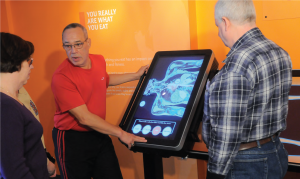 interactive display provides feedback on whether the selected meal is sufficiently balanced. It also provides alternative food choices. As you work your way around the exhibit hall, you’ll encounter the Label Decoder, Sugar Detective, Dollars and Scents, Know Your BMI, Exertainment and FIT Center (FIT is an acronym for frequency, intensity & time). You can probably make an educated guess at what each offers, and you’d be right. The key thing here is that Calderon (left) has seen to it that each section over-delivers. Two good things to know about Generation Fit. First, to avoid the chaos and disorder that sometimes diminish other interactive children’s exhibits, the Newark Museum will probably be time-ticketing the exhibit. This is a great idea. Call ahead to get details on this. Second, the crowded times for Generation Fit will probably be between noon and 2:00 pm. Plan accordingly.
interactive display provides feedback on whether the selected meal is sufficiently balanced. It also provides alternative food choices. As you work your way around the exhibit hall, you’ll encounter the Label Decoder, Sugar Detective, Dollars and Scents, Know Your BMI, Exertainment and FIT Center (FIT is an acronym for frequency, intensity & time). You can probably make an educated guess at what each offers, and you’d be right. The key thing here is that Calderon (left) has seen to it that each section over-delivers. Two good things to know about Generation Fit. First, to avoid the chaos and disorder that sometimes diminish other interactive children’s exhibits, the Newark Museum will probably be time-ticketing the exhibit. This is a great idea. Call ahead to get details on this. Second, the crowded times for Generation Fit will probably be between noon and 2:00 pm. Plan accordingly.
Editor’s Note: The museum is located at 49 Washington Street in the Downtown Arts District, a couple of minutes away from NJPAC, and is open Wednesday thru Sunday from noon to 5:00 pm. Generation Fit uses research data from the Robert Wood Johnson Foundation and Center for Disease Prevention, the national Let’s Move! Initiative, National Institute of Health and scholarly journals.
Addiction is an issue that impacts everyone in some way. To overcome addiction—whether it is your own, a friend’s or a loved one’s—it is crucial to understand what addiction is, how it works, and why it is so easy to fall back into unhealthy habits. Trinitas psychologists Dr. Rodger Goddard and Dr. Patricia Neary-Ludmer discuss the role that “triggers” play in addictive behavior…
Goddard: There are many definitions of addiction including those that are used in a clinical psychiatric setting and those that are used in everyday language and everyday settings. A broad definition of addiction involves things that we consume or do compulsively, that are injurious to our health or happiness, and are very difficult to give up. These can be referred to as health-compromising habits. Health compromising habits may include compulsive shopping, unhealthy eating, overuse of computers or video games, self-doubt, negative emotional states, and so on.
Neary-Ludmer: Another important aspect of addictions— whether we are referring to eating disorders, substance abuse, compulsive behavior or tobacco use—is that they can be viewed as unhealthy coping behaviors. Boredom, anxiety, depression, trauma and failure are just a few of the triggers that might be antecedents to these addictive behaviors. When the unhealthy behavior leads to a reduction in the unwanted feelings, the behavior is reinforced. For example, a high-school student feeling rejected by peers may restrict eating or purge as a way of feeling more in control. Self- destructive cutting behavior also can lead to a reduction in emotional pain. And of course numbing emotional pain through the use of alcohol and drugs is a common pathway to addiction. Problems disappear for the moment, but are still there once the drugs and alcohol wear off.
Goddard: Triggers are the actions, events, people and things that initiate the addictive action. Triggers may become almost as rewarding as the addiction itself—they elicit brain chemistry changes similar to the actual addictive substance or behavior. They trap and lock us into the addiction. For alcoholics, the sound of ice jiggling in a glass, a bottle being opened, or the pouring of wine, beer or gin can heighten the urge for relief from stress by having a drink at the end (or beginning!) of our day.
Neary-Ludmer: How does one avoid or control these triggers? Support groups and therapists will warn the individual to stay away from the people, places and things that may trigger by association a need to drink, use drugs, gamble, smoke, cut or engage in eating disorder behaviors. They must build new friendships, interests and places to go. Obviously, drug addicts can be triggered by being with old buddies they got high with in the past. But they even need to avoid their old haunts, which serve as a reminder of the good times and put them at greater risk to use again.
Goddard: Substituting a new social network can be an important trigger-stopper. This is why Alcoholics Anonymous is so successful at helping alcoholics to overcome their addiction. An alcoholic can now socialize with people who are not popping corks and bottles.
Neary-Ludmer: Also, there may be a stimulus or an event that is so threatening that an addict feels the need to return to unhealthy behaviors. At this point you need someone to call to support you. In AA or Narcotics Anonymous, you have a sponsor to call and meeting you can attend. This is also a good time to have a therapist in place, to help see you through tough times.
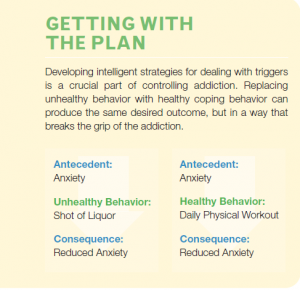 Goddard: The greater our ability to identify a trigger, the stronger we become at overcoming an addiction. Trigger awareness can help us to substitute a behavior that does not injure our health or quality of life. When we can identify our triggers it is possible to stop the negative action before it takes us over. Writing down triggers can be a first step in overcoming addictions. Sometimes we are able to overcome an addiction on our own, but sometimes it is critical to get help from a therapist, clinic or professionals that specialize in addiction.
Goddard: The greater our ability to identify a trigger, the stronger we become at overcoming an addiction. Trigger awareness can help us to substitute a behavior that does not injure our health or quality of life. When we can identify our triggers it is possible to stop the negative action before it takes us over. Writing down triggers can be a first step in overcoming addictions. Sometimes we are able to overcome an addiction on our own, but sometimes it is critical to get help from a therapist, clinic or professionals that specialize in addiction.
Neary-Ludmer: Unfortunately, all triggers are not avoidable. This is why it’s so important for an individual to make that plan…and manage those triggers that simply can’t be predicted or avoided.
Editor’s Note: Dr. Rodger Goddard is Chief Psychologist at Trinitas and Director of the hospital’s wellness program which provides companies, agencies and schools with onsite programs to improve health and productivity. Dr. Patricia Neary-Ludmer manages the Family Resource Center in Cranford, which is affiliated with Trinitas’s Department of Behavioral Health and Psychiatry.


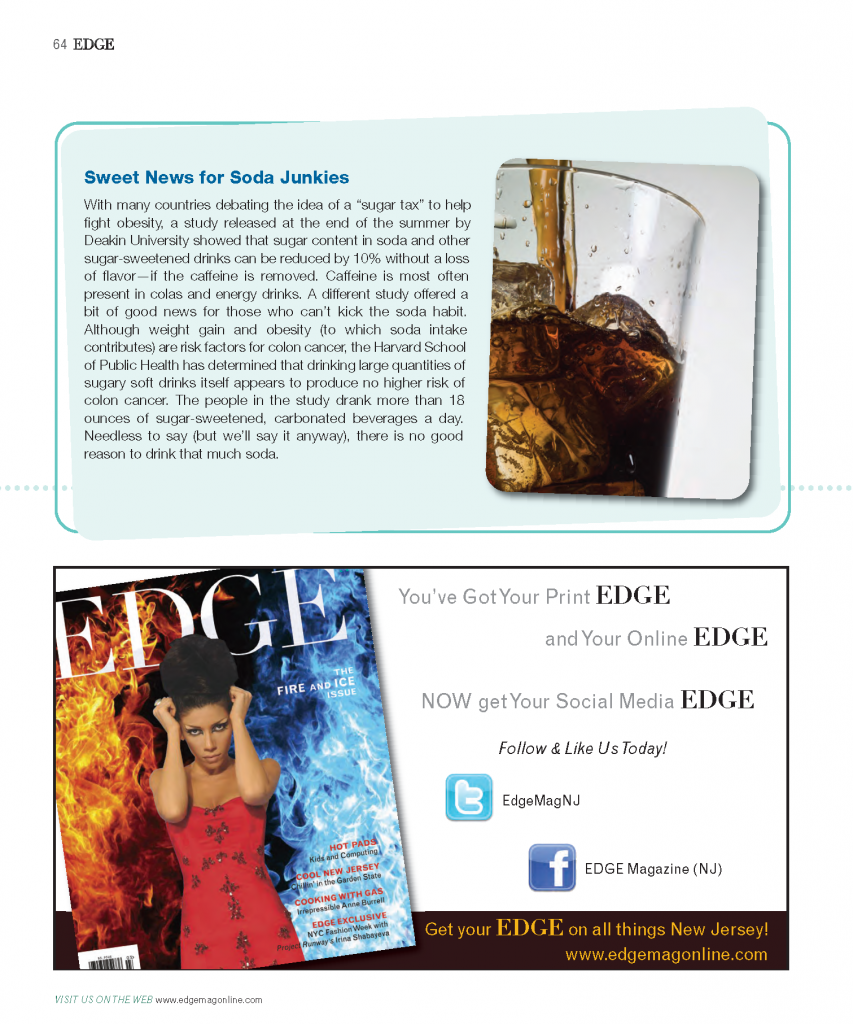
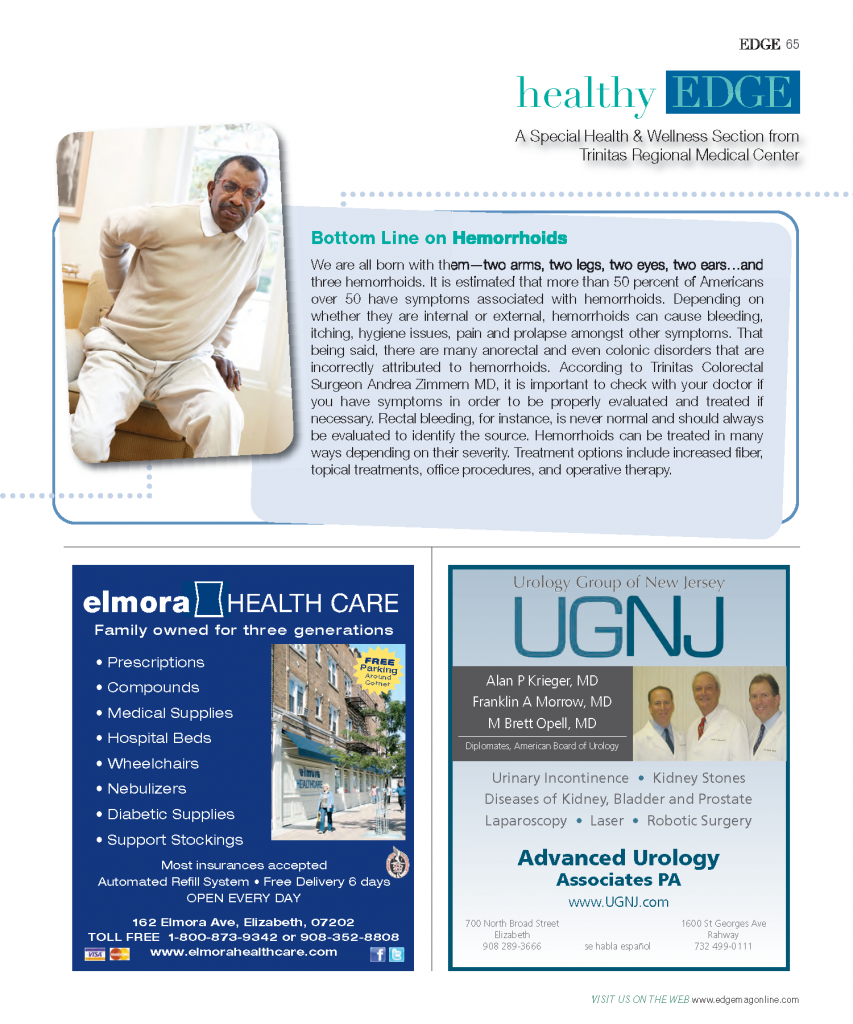
There is no greater joy for a father than seeing his daughter follow him into the family business. Because of the business he’s in, Joe Mantegna is granted the added pleasure of literally watching his daughter, Gia, as she makes a name for herself on stage and screen. Every Hollywood family deals with this dynamic a little differently, of course. Yet as J.M. Stewart discovered during a leisurely meal at Taste of Chicago in Burbank, Joe and Gia handle it particularly well. If you’re one of those people who thinks that acting is an art and parenting is a job, well, this interview may change your mind. For the Mantegnas, it’s clearly the other way around.
EDGE: I would like to start by avoiding the obvious question, which goes something like, ‘Gia, what have you learned about acting from your father…’ (simultaneously)
JM: Everything. (simultaneously)
GM: Nothing. Absolutely nothing.
EDGE: Okay then. Well, in the spirit of avoiding that question, Joe, what have you learned from watching Gia?
JM: Part of what I’ve learned is that what we do is inherent. It’s just there. When I became an actor, I saw the children of actors working and wondered, What’s that about? Would they have even gotten into acting if they weren’t following their parents? I came from a background of no actors, nobody in my family was is show business at all. I thought, This can’t be genetic. It must be one of those things where the kids go, ‘Oh, my dad’s doing it so I’m going to do it.’ But then I’d see Jane and Peter Fonda, and Jeff and Beau Bridges and think, Oh, they’ve got it. As I got more into the business, I started to realize that they’re good because it’s in them. I’ve been around enough actors now to know that you can teach some things, but you’ve either got it or you don’t got it.
EDGE: Like sports.
JM: Right. You can see the kids that have the kind of natural ability they can improve upon. And then there are the kids that, well, it’s not their cup of tea. Gia does have it. I’m not kidding myself because she’s my daughter. I would be the cruelest critic of all if I felt she didn’t have that thing she can build on. I would have told her years ago, ‘I know that you think this is fun and all, but it’s not for you.’ If anything, I have to instill in her not to be like I am, not to be lazy about it.
EDGE: Lazy in what respect?
JM: I found myself thinking, I can do this, I don’t need to work on it that much. I’m not the most driven actor in the world. But I’ve gotten by and made it in spite of that.
EDGE: If you were more driven, how do you think it would have affected your career?
JM: Maybe things would have happened sooner if I had focused more attention on it. Maybe not. I don’t know. But it wasn’t me. I’ve seen other actors do that. Every day they devote twenty-four hours to How can I succeed? I was, like, If it happens, it happens. I never pushed myself to where it infringed on my life, to where I really had to sacrifice something. I enjoyed it, I wanted it to be fun. That’s my approach to a lot of things. I didn’t think, Oh my God, if I don’t make it I’ll die! I was, like, If things don’t work out, I’ll become a forest ranger.
GM: A forest ranger? Really?
JM: In reality, I probably would have been a photographer.
EDGE: Gia, what percentage of your father’s work have you seen?
GM: Five percent. I’ve seen very little because most of it was released when I was too young to watch, or it was R rated. Half the films he dies in and I was too frightened to watch. I remember flipping through the channels watching a movie, and I saw my dad walking down the street with a bouquet of flowers. I went, Yes! Dad’s on TV in something I can watch, this is so cool! A couple of minutes pass and he’s shot down with a machine gun. It affected me much more than I thought it would. I remember seeing Baby’s Day Out when I was four. We thought, Finally he did a movie that the family could watch. We’re sitting on the bed, my sister’s right next to me, and here comes the scene when the baby’s in his pants, lighting his crotch on fire.
JM: Yeah, we’re thinking it’s a great family movie. But I get beaten up by gorillas and blown up. It was a horror film to them.
GM: It was awful. I remember running out of the room crying. And dad’s hitting his face, saying, ‘Look it’s me, I’m okay. I’m here.’ So I never really sat down and watched my dad’s movies, because he was probably going to get the crap kicked out of him.
EDGE: Even now?
GM: Well, I watch Criminal Minds. But I can’t really watch it alone because it’s such a terrifying show.
EDGE: Joe, Gia has been in a couple of movies where she’s strung up and begging for her life—
GM: Apple doesn’t fall far from the tree, I guess.
EDGE: Joe, do you have the same reaction?
JM: I know the process. I’m totally familiar with it. I can disassociate. It’s disturbing, but I know what’s going on.
GM: My mom sometimes has to leave when she’s on set during those kinds of chilling scenes. She freaks out.
JM: In his book, David Mamet writes about a memorable directorial moment during House of Games. He was shooting the scene at the end when I get shot. It’s a night shoot, we’re up at Sea-Tac Airport. My wife is watching on the monitor sitting next to Dave. I get shot, and she starts crying.
GM: I never knew that.
JM: Dave was like, Wow, this is wild. She’s into it. She’s crying. She’s totally in the scene. He remembered it and put it in his book. I didn’t know about it—I was doing the scene. So, I understand that anyone can get caught up in the moment.
GM: I saw Three Amigos last night. It was pretty hilarious. I didn’t even know you were in that until I turned it on, and there you were. If I’m ever watching something that you’re in, it’s probably coincidental.
EDGE: Have you had a moment watching your father where you said, ‘Wow, that was really good?’
GM: I’m not going to lie to you. It’s very hard to watch anyone I know in a movie or on TV and be objective, or even remove myself from thinking of the technicality of the scene. I’m always thinking, How did they do that in one shot? Was there a problem with the continuity? Why did the actor make those particular choices? I’m young. I’m still learning. I’m trying to figure it out, break it down. If I analyzed everything he did, I’d drive myself crazy.
EDGE: Joe, have you ever seen Gia’s work and gone, “Wow, that was impressive?”
JM: The time I saw her in Annie. There were open auditions and my older daughter, Mia, who is autistic, was also trying out for it. They came home and said, ‘We both got in!’ My wife and I were really excited, but I have to admit that we were mostly excited about Mia, because she was going to be cast in a play. It was a big deal. I thought they both would have been cast in the chorus. We asked, ‘Who are you going to be?’ Mia says, ‘I’m going to be Pepper.’ Great! I said, ‘Gia what are you doing?’ She says, ‘I’m Annie.’ I didn’t even know she sang!
EDGE: How old were you?
GM: I was really young. We had to lie about my age. I was turning the minimum age you had to be, but I wasn’t there yet. I was ten.
JM: That’s when I first knew she had it. Based on her age and everything, you could tell. I sent the tape of the show to my old drama teacher and he said, “It was like seeing you again, Joe, when you were starting.’
EDGE: Will we hear you sing again, in a movie or on stage?
GM: Oh, no.
JM: You should. You really should.
GM: My mom thought that I was going to be a singer. But I was always terrified of the music industry because I felt like there was so much competition, and you had to pick your style and stick with it. Every five minutes I’d be changing my genre. Acting was just something that was a little more natural for me. Maybe in the future I’ll sing. My mom and dad would like that.
JM: That’s one thing I think you should really do, musical comedy. You have the talent. Why not just give it a shot? That’s what I thought I was going to end up doing, because I did so much of it when I started out. I did Hair. I did Godspell. It didn’t work out that way, but you never know.
EDGE: When did you do Hair?
JM: In 1969. It was the first professional play I did. I was naked on stage every night.
EDGE: What did your mom think of that?
JM: She came opening night. The other actors were not keen on having their parents there, so they asked me, ‘Is she cool?’ I said, ‘Yeah, yeah, she’ll get it.’ And after the play my mother comes backstage and says, ‘You look good up there naked…some of these other kids look out of shape.’ The cast couldn’t believe it. But that’s my mother. It’s all a mystery to her.
EDGE: How so?
JM: My mother just turned ninety-six and I’m still not positive she knows what I do. I asked my brother, who is eight years older than me, ‘You know all the times I was pursuing acting in high school, in junior college, and professionally, and banging around Chicago…my parents never said one word about it to me, did they say anything to you?’ He said, ‘Yeah, one time they pulled me aside and asked, What’s with your brother and this acting? Should we say something? Should we stop him?’ They were looking to him for advice. Luckily, my brother in his wisdom said, no, just leave him alone. It’s not dangerous, and if it doesn’t work out he’ll move on to something else. I think they were relieved. It’s like the sex education talk my father never gave me. I was seventeen and he came up to me and said, ‘Listen, we need to talk about sex.’ I said, ‘No… we don’t.’ He was like, Okay. Being Sicilian he was quiet anyway, but it was another burden off his shoulders.
EDGE: In the film Uncle Nino you worked together as father and daughter. Was it totally natural, or totally nervewracking?
JM: I thought it was totally natural.
GM: I thought that situation was great because it gave me the opportunity to experience a set for the first time with my dad helping me through it.
JM: It was a perfect film for her to start with. It was a feelgood movie. Bob Shellcross wrote and directed it. I loved the guy.
GM: Yeah, it was like a family.
EDGE: Gia, where would you like to be five years from now as an actress?
GM: I hope that I am doing something that makes me happy, and I hope that I can continue to stay with the choices I make for myself instead of being told what to do. At my age it’s very easy to be typecast in a certain way, and I’ve been so scared of that. I have friends who are working every day, making money, supporting themselves, but they’re not happy. I’d rather be making five amazing, little independent films, playing lots of different characters, doing something fun, instead of doing one role that you can’t break out of.
JM: She doesn’t want to be a Disney kid.
GM: Okay, dad, I didn’t want to say that.
JM: I don’t mean specifically. I mean generally. You’re put in a bag in a cookie-cutter kind of way. That’s all I’m saying.
EDGE: Okay, so here’s the big Joe Mantegna’s daughter question—
GM: O-M-G! Bring it.
EDGE: Which question about your dad are you most tired of answering?
JM: Why is he so good looking.
GM: Yeah, that one. You know I actually creep on my dad’s IMDB sometimes, and people say things like Joe Mantegna is SO hot.
JM: I better check that out.
GM: So disturbing.
Editors Note: Gia Mantegna is 21. She played Vanessa on the series Gigantic and has a lead role in the featured film Leashed, which will be released in 2012. Joe Mantegna is the star of the CBS hit Criminal Minds. He will play Bugsy Siegel in the 2012 film Kill Me, Deadly. J.M. Stewart is a freelance writer who lives north of Los Angeles. As the waiters were clearing their table, Gia said that it was nice to “sit down with my dad and talk. We don’t do that that much. We just have dinner and that’s it. Thank you.”
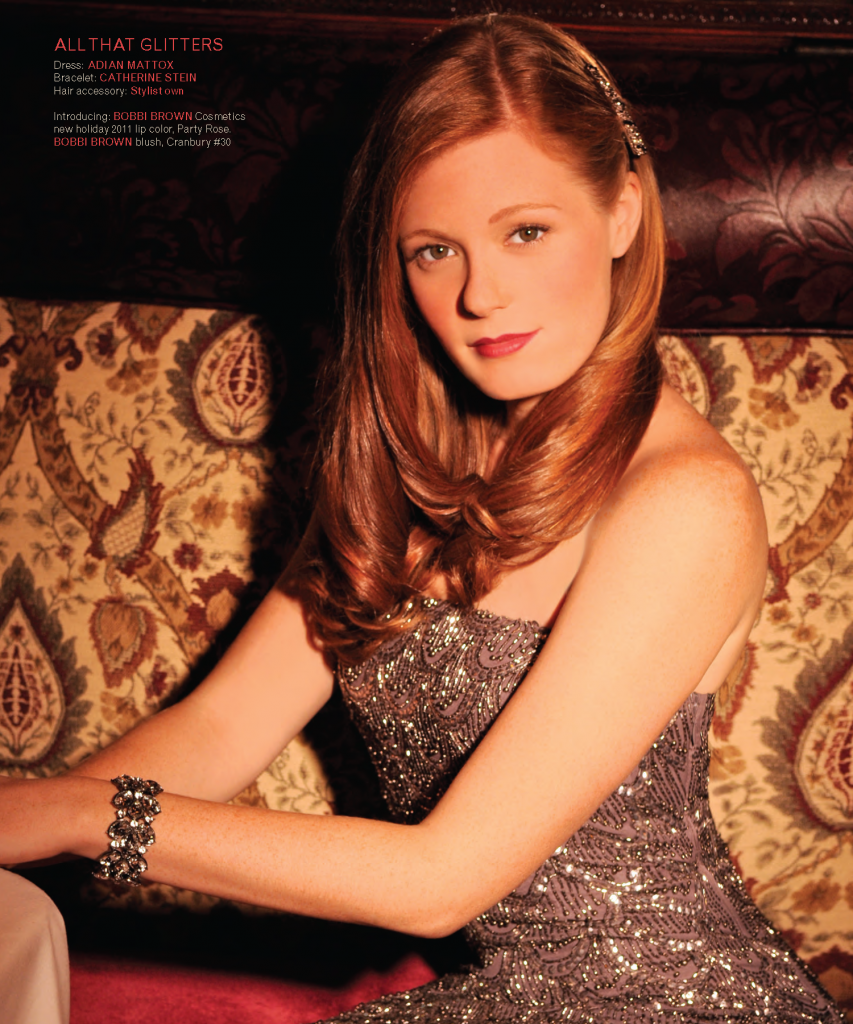


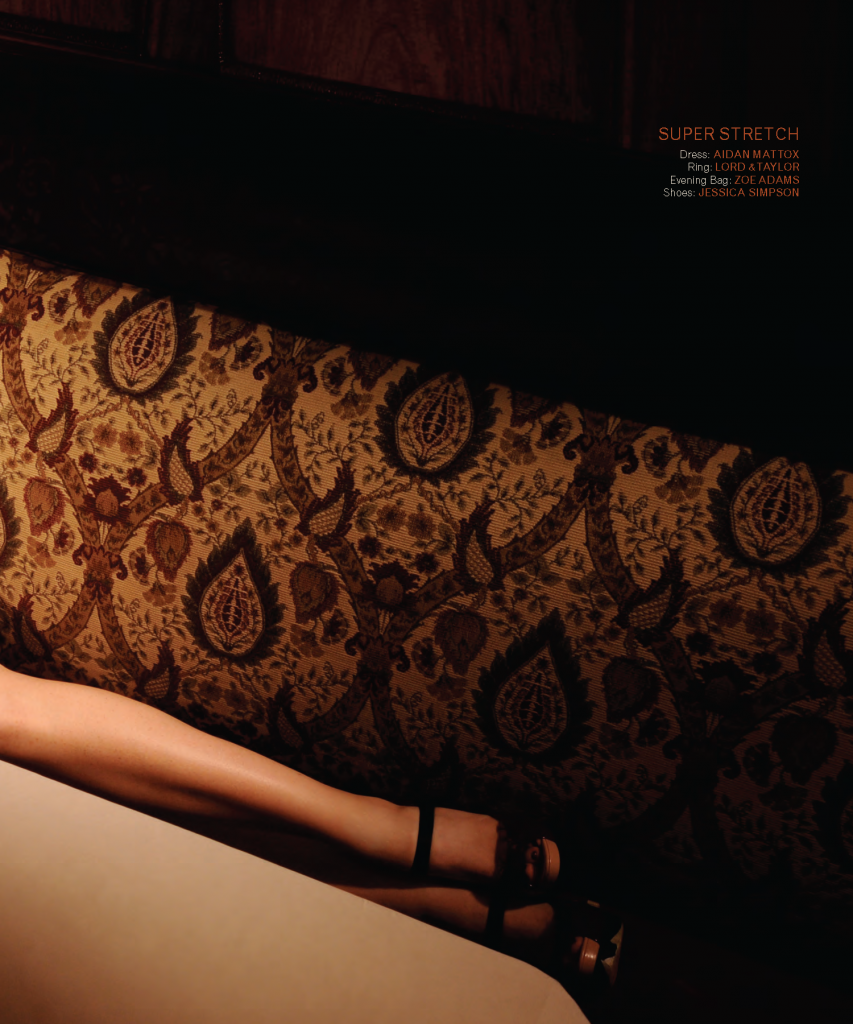
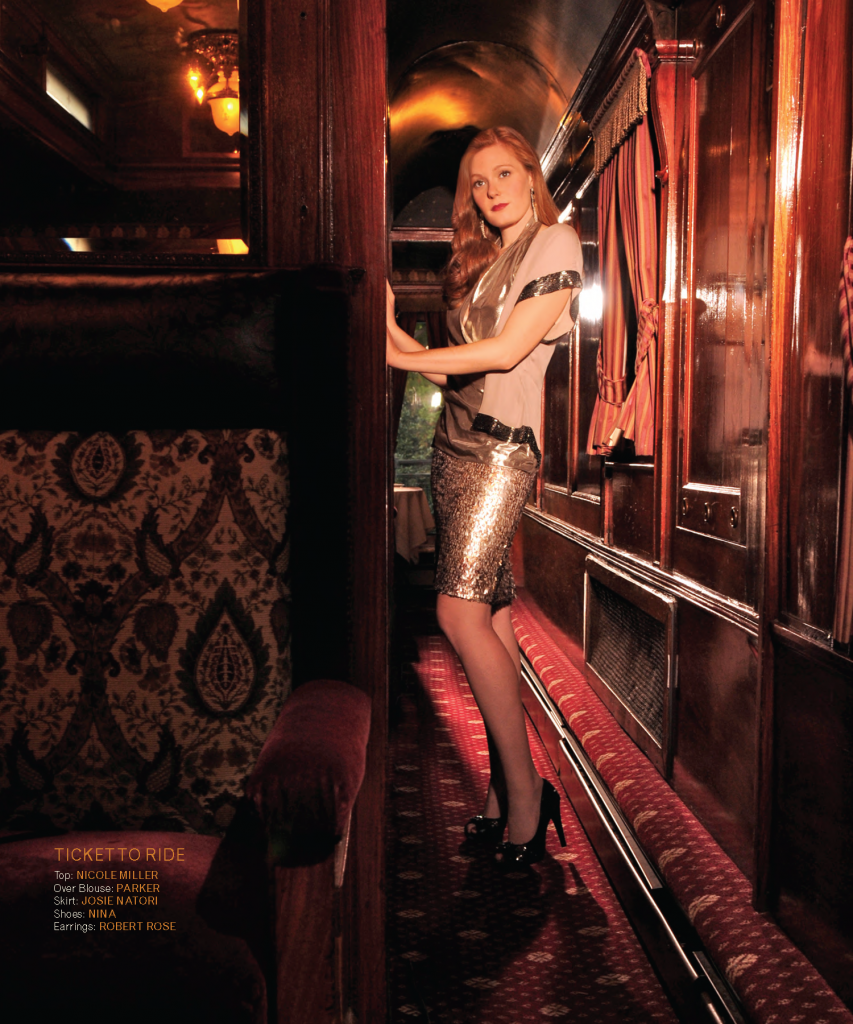

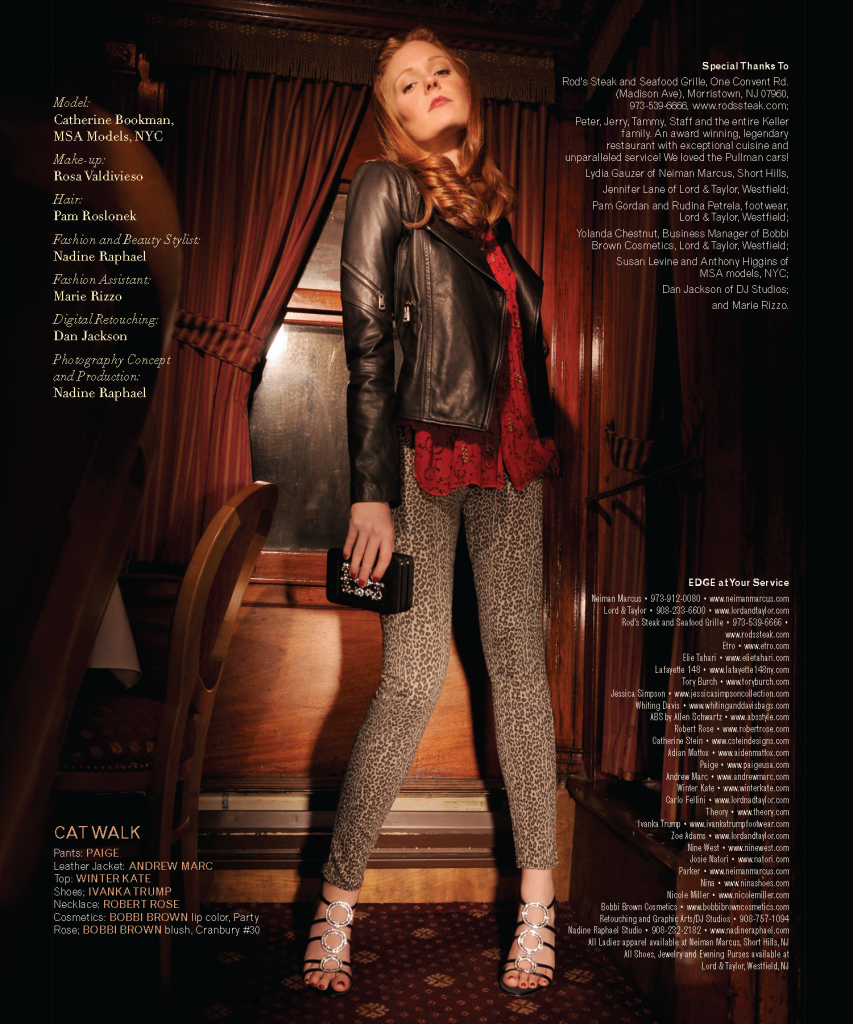
We Americans are a competitive breed. We go for the gold and shoot for the stars. Perhaps that’s why more than 50 million of us drop everything to tune into the Oscars, Emmys, Tonys & Golden Globes…and countless millions more follow the pre- and post-show activities on our TVs, iPads, laptops and smart phones. It certainly explains why New Jerseyans are particularly proud when “one of our own” takes the stage to grab a piece of that coveted hardware. Here’s a look at some Garden Staters who have taken Acting Out to award-winning extremes…
 The Envelope Please…
The Envelope Please…
Michael Douglas (b. 1944, New Brunswick) • Received his first Oscar in 1975 as Best Picture producer (One Flew Over the Cuckoo’s Nest). • Accepted the 1987 Best Actor Oscar as Gordon Gekko in Wall Street. • Won 3 Golden Globes (including one as producer of Romancing the Stone).
Linda Hunt (b. 1945 Morristown) • Won the 1983 Oscar for Best Supporting Actress for playing Billy Kwan in The Year of Living Dangerously, becoming the first person to win for portraying someone of the opposite sex.
Jack Nicholson (b. 1937 Neptune) • One of only three actors to win three Oscars (two for Best Actor in One Flew Over the Cuckoo’s Nest and As Good as It Gets and one for Best Supporting Actor in 1983 for Terms of Endearment). • Record holder for most nominations (8 for Best Actor and 4 for Best Supporting Actor).
Joe Pesci (b. 1943 Newark) • Won 1991 Best Supporting Oscar for Good Fellas. • Nominated 10 years earlier for Raging Bull.
Eva Marie Saint (b. 1924 Newark) • Won Best Supporting Oscar for On the Waterfront. • Received a Golden Globe nomination for her performance in A Hatful of Rain. • Won an Emmy for the mini-series People Like Us in 1990.
Frank Sinatra (b. 1915 Hoboken) • Won the 1954 Best Supporting Oscar as Maggio in From Here to Eternity and was nominated for Best Actor two years later as The Man with the Golden Arm. • A trio of Oscars for Best Original Song, and Golden Globe Best Actor wins for Pal Joey and Come Blow Your Horn. • Hosted the Academy Awards broadcast in 1963. • Awarded the Presidential Medal of Freedom by President Reagan in 1985.
Kevin Spacey (b. 1959 South Orange) • Won his first Oscar as Best Supporting Actor in 1996 for The Usual Suspects, and his second as Best Actor in American Beauty in 1999. • Artistic director of London’s Old Vic theatre since 2003.
Meryl Streep (b. 1949 Summit) • Nominated an astonishing 16 times (more than any other actor), winning it twice (for Kramer vs Kramer and Sophie’s Choice). • Received the most Golden Globe nominations (25 total, winning 7). • Earned a pair of Emmys and a Tony nomination, as well as the 2004 American Film Institute’s Lifetime Achievement Award.
John Travolta (b. 1954 Englewood) • Won a Golden Globe Award for Best Actor in Get Shorty. • Nominated for the Best Actor Oscar for Saturday Night Fever and Pulp Fiction.
 No Time Like Primetime…
No Time Like Primetime…
Danny DeVito (b. 1944 Neptune) • Won both the 1980 Golden Globe and 1981 Emmy as Louie De Palma on Taxi. • Earned an Oscar nomination as co-producer of Erin Brockovich in 2001.
Peter Dinklage (b. 1969 Morristown) • Won 2011 Best Supporting Emmy for HBO’s Game of Thrones.
John Forsythe (b. 1918 Penns Grove) • Nominated for Golden Globe six times, winning twice. • Emmy-nominated 4 times.
James Gandolfini (b. 1961 Westwood) • Won three Emmys as Tony in The Sopranos.
Ernie Kovacs (b. 1919 Trenton) • Received his only Emmy posthumously. • Emmy-nominated three times for The Ernie Kovacs Show.
Loretta Swit (b. 1937 Passaic) • Won a pair of Emmys as Hot Lips on M*A*S*H.
Jack Warden (b. 1920 Newark) • Won an Emmy for playing George Halas in Brian’s Song. • Oscar-nominated for Shampoo (1976) and Heaven Can Wait (1979).
 Curtain Call
Curtain Call
Jason Alexander (b. 1959 Newark) • Won a Tony pre-Seinfeld for his appearance in Jerome Robbins Broadway in 1989. • Earned Emmy nominations each year from 1992 to 1998.
Nikki James (b. 1951 Summit) • Won a 2011 Tony as Best Featured Actress in a Musical for The Book of Mormon.
Jane Krakowski (b. 1968 Parsippany) • Nominated for a 1990 Tony for Grand Hotel and won in 2003 for her performance in Nine. • Nominated for Emmys 2009–2011 for 30 Rock.
Phyllis Newman (b. 1933 Jersey City) • Edged out Barbra Streisand for the 1961 Tony for her role in Subways are for Sleeping.
Some Very Honorable Mentions These New Jerseyans made huge contributions on stage, screen and television but were overlooked when it came time to pass out the serious hardware…
Bud Abbott (b. Asbury Park 1895)
Lou Costello (b 1906 Paterson)
Jerry Lewis (b. 1926 Newark)
Judith Light (b. 1949 Trenton)
Ozzie Nelson (b. 1906 Jersey City)
Unmentionable • The cast of MTV’s Jersey Shore. • Anyone who watches it.
Vincent Pastore is a hard man to pin down. His interests are many, his gears constantly turning, his attention often divided. Tracey Smith chased him all summer for this interview, hoping to capture the essence of a show business Renaissance Man. To her delight, Pastore turned out to be that Renaissance Man in every conceivable way. Indeed, one can easily imagine him perched upon the throne of a 16th century city-state…or transforming a block of marble into a masterpiece for a wealthy patron…or dodging the business end of an enemy lance at the vanguard of an attacking army. From his tour de force as the conflicted criminal underboss Salvatore “Big Pussy” Bonpinsiero on The Sopranos to his unforgettable stints on reality TV, Pastore has become one of the most cherished characters—and character actors—of our time.
EDGE: The bad guys on The Sopranos could be warm and vulnerable and then suddenly turn and become cold, heartless killers. Your character had the added dimension of being deeply conflicted about being an informant. Did you enjoy that extra challenge?
VP: I did. David Chase wrote that role for an actor who could play a tough guy who also could be sensitive. I saw Big Pussy as a man with a big heart, and that was my choice of how I played that role. In that scene where he is crying in the bathroom at Anthony Jr.’s confirmation, you knew it was not just because he was a rat—he was betraying his friends, which was even harder to deal with.
EDGE: Was Big Pussy the most subtly textured character you have played in your career?
VP: Hmm, that’s a tough question. Probably. Going through so much mental turmoil over such a long period of time, dealing with the tension of if and when he was ever going to get caught by his friends for being an informant. I can tell you that it stayed with me as an actor, over five days a week of taping. It was rather tough.
EDGE: In addition to your acting, you are involved with a lot of plays.
VP: I try to produce three plays a year. It really enables people to see the actors work. I started doing this four years ago. It’s enabled me to continue working with several actors from The Sopranos, including Maureen Van Zandt, Nicholas Giangiulio, Joe Lisi, Garry Pastore, Tony Rossi, Anthony Ribustello and Janet Sarno. I don’t make a lot of money because I own the theater company, but we’ve had a pretty good run.
EDGE: Is that a different kind of stressful?
VP: Yes. The behind-the-scenes aspects of theater can be very stressful. I recently co-produced the revival of Lamp Post Reunion by Hoboken playwright Louis LaRusso. Danny Aiello played the lead character. There were frequent worries about who was ready or on cue. Plus the mood of the main character was dark.
EDGE: Your television and film roles are typically big, rich characters. How much of what we see on screen is you, and how much of that is you slipping into character?
VP: That depends on the role. I am currently being filmed as a mayor in Surviving Family and I’m not acting like the typical wiseguy that I’ve played in the past, like Angelo Ruggiero from Gotti or Big Pussy from The Sopranos. In Surviving Family I am acting, whereas those other characters are closer to who I am. I am Angelo. I am Big Pussy. And trust me, playing a mayor is a whole lot different than playing a wiseguy. There’s no comparison.
EDGE: What about the over-the-top Vincent Pastore we’ve sometimes seen on reality television shows, like Famous Food, The Apprentice and Celebrity Fit Club?
VP: What reality producers try to do is put me up against certain situations to bring out the best or worst in me, which is what the reality television mission is, in all actuality. They place you in a bad improvisation scene with someone you genuinely don’t like, and you’re forced to work with them. They want drama, emotion and conflict. Sometimes my temper shows, but I believe that as long as you don’t take it home to your family, and keep it out of your personal life, it’s okay.
EDGE: You pointed out in a previous issue of this magazine that not everyone can play a wiseguy. By the same token, no two wiseguys are alike. Big Pussy was a fictional character. But the part you played in Gotti was not. What was the challenge in interpreting that role?
VP: Angelo Ruggiero was a real person, so it was key to know the relationship between the two men. John and Angelo had a priceless bond. Armand Assante, who played Gotti, told me that the song The Wind Beneath My Wings reminded him of Ruggiero. He was always right behind John Gotti. He was loyal, and he never ratted. So you have to do the research, know the character. It’s true—not everyone can do this, not everybody can play a wiseguy.
EDGE: You mentioned that Angelo Ruggiero and Big Pussy are “you.” How often do you reach back and draw on your experiences outside the theater, to the real-life characters you’ve known, when you play a part?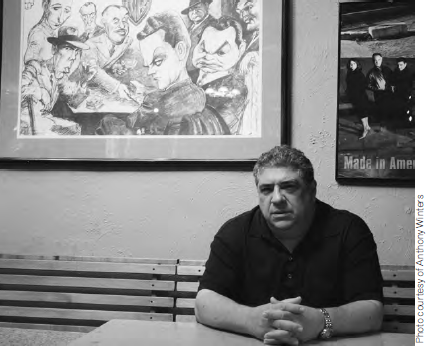
VP: A lot of people think I grew up with those kinds of people. The truth is that I grew up in a pure Italian-American home. Tradition. We lived in New Rochelle in an Italian neighborhood. I can still smell the pizza! Roller skating every Friday night at the Boys Club. Great memories. We saw bookies and loan sharks. But to play these roles you don’t rely on memories. You use your own personality and come up with a great character. And for the record, I never knew any rats.
EDGE: Your family lived above a social club.
VP: The Forester’s Club of America. It’s still there. When I was a kid, I packed the cases of beer, cleaned up after the card games. I still can remember the smell of the stinky ashtrays—which probably had an influence on me later owning a bar. Most days I would get there at 3:00. My dad was a school custodian. He’d get back around 6:00. My mom cooked for the men at the bar on the weekend. There was a big hall in the basement where they would play team games and card games. There was an annual picnic, a Christmas party. A lot of meetings took place here.
EDGE: Sounds like a typical Italian-American social club.
VP: Yes, but not like a John Gotti “social club.”
EDGE: Is it true that you got into acting through Matt and Kevin Dillon?
VP: It was really Kevin Dillon who got me my first break. I used to drive a limo in New York and that’s when I met the brothers for the first time. I told them about my dreams of becoming an actor. They ended up seeing me at this community theater I was doing, and Kevin helped me out. He gave me the direction I needed to finally act. From there, Danny Aiello really became my mentor.
EDGE: One last Sopranos question. Your partner in crime, Pauly Walnuts, went from one line in the first episode to mob superstardom. How did that go down?
VP: The Sopranos was my dear friend Tony Sirico’s last hurrah. He had been in the business for twenty years, had come up through the ranks of indie films, and he had to make an impact. He had to get physically and spiritually more space. In the pilot his one line was Barone wants to talk to you. My part was much bigger. David Chase liked Paulie Walnuts, so he made Tony a technical assistant, and eventually wrote him in more and more.
EDGE: What was it like sharing a scene with a character like Paulie Walnuts?
VP: Like sharing a camera with an elephant! He wanted the whole camera, (laughing) but he let me squeeze in there from time to time. Tony was so experienced. I respect him so much. He always came to work prepared, ready, knew his lines, make-up was perfect. I truly learned from him.
EDGE: Is there a brass-ring role that’s out there for you? Is there a character you were born to play?
VP: I’d love to be on a sitcom. I’d love to finally play someone warm and funny.
Editor’s Note: Tracey Smith is a freelance writer who lives in Chicago. She is working on a book about contemporary films on gangsters and organized crime.
’Tis the season. No, not of family gatherings and holiday cheer. For college-bound seniors and their parents, it’s crunch time.
College admissions officers are bracing themselves for the tsunami. Over the next few weeks, the steady stream of applications they have been wading through will turn into an unstoppable torrent. One of the countless charms of the Internet is that it has made the process of applying to multiple schools incredibly simple. A generation ago, high-school seniors would pick a handful of schools—including a reach and a safety—fill out the paperwork by hand, lick the envelope, stamp it, and send it off. Thanks to the common application (aka The Common App) and the wonders of technology, today every one of the 3.5 million teenagers thinking about college can apply to 20 schools with only slightly more effort than it took to lick those envelopes. One thing about teenagers hasn’t changed. No matter how easy the computer has made it for them to apply to college, they somehow find a way to turn the process into a full-on heart attack anyway. The majority of kids will be pushing the SEND button on their applications just a day or two before the deadline. Some will take it down to the final minutes or seconds. While frustrating for parents, engaging in this type of brinksmanship isn’t what should concern the moms and dads of college-bound seniors. The critical time-management issue is making sure that enough thought and effort have been devoted to the creation of an essay for the common application that grabs the attention of even the most overwrought admissions officer. It is the piece that tells a college who a young person is, and helps determine whether he or she would be a good fit for the school. Is your senior‘s essay done? I’m guessing the answer is no. Remove your fingers from around your child’s neck for a moment and take a look at what another kid did. I asked four professionals in the college admissions process to critique this essay. I made it clear that the writer had already matriculated, so we weren’t fishing for praise. Instead, we were looking for specific, constructive criticism that would help members of the Class of 2013 evaluate their college essays as the application deadline nears….
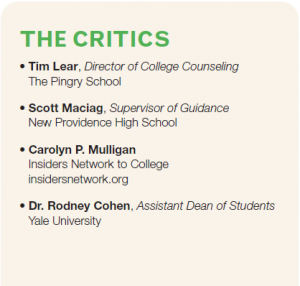
THE ESSAY When life hits you in the face, react with your head, not your hands. I never really knew what my parents were talking about until that awful Sunday afternoon in May. I had struck a section of guardrail with such force, and at such an unusual angle, that it lifted two of the supporting stanchions completely out of the ground. Luckily, I was unhurt. The culprit was long gone. Not a drunk driver. Not some idiot wolfing down a Quarter Pounder while texting on his cell phone. Rather, it was an enormous beetle that had flown through the open, driver-side window—smack into my face. A novice behind the wheel, I swerved left, over-corrected right, and finally lost control at 50 miles per hour. Precisely six weeks after posing for my first driver’s license photo, I had become a cliché. I was shocked and angry and embarrassed. The car was a twisted wreck. It had collapsed around me, absorbing the energy of my high-speed, metal-on-metal encounter. Totaled. It was only later, when I saw photos of the car and revisited the scene of the accident, that I realized how fortunate I was. Had I swerved 20 feet sooner I might have been cleaved by a telephone pole. Had I left the road 20 feet farther down the hill, I would have launched myself into a ravine. Teenagers are not wired to contemplate their own demise, yet whenever I drive past this spot it is hard to think of anything else. In time I realized something slightly more profound. By handing the keys to a newly minted driver, mom and dad were giving me that first terrifying (for them) taste of true independence that’s part of the letting-go process of parenthood. While all I saw was the upside, they had quietly thought through the downside and purchased the automotive equivalent of a Panzer—a used Audi wagon that was basically conceived and constructed to crash into guard rails and deliver young drivers back to their parents older, wiser and relatively unscathed. I might mention here that I had lobbied briefly for a Thunderbird convertible (yeah, dream on!). It’s less than a year later and my parents are now preparing to hand me the keys to a college education. They will be writing out another large, painful check and making me the driver of my own life. How terrifying this is for them I can only guess. Recently, I found myself telling a friend “when life hits you in the face, react with your head, not your hands.” She wasn’t really sure what I was talking about, but a few weeks later, she found herself wrapped around a telephone pole thanks to an adventurous squirrel. At this point, it is safe to say that almost everyone in our group of friends has both heard and understood this bit of wisdom. Of course, part of giving advice is accepting that advice yourself. And in that spirit, I would like to tell my parents what I have learned. Next time I will react with my head and not my hands. That’s a no-brainer, so to speak. And although I still feel indestructible, I also know grave consequences await both my actions and in-actions. Mostly what I’d like to tell them is that in choosing a college, I now know I’m looking for the Audi, not the T-bird. I’d like to tell them…but I won’t. As they taught me, sometimes you just have to figure things out for yourself.
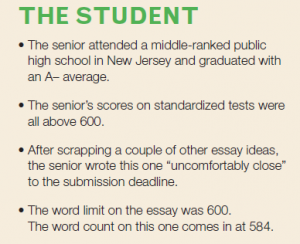
THE FEEDBACK All four of our experts agreed on two things. The essay demonstrated excellent writing skills, but also fell short of that certain something admissions officers love to see in an essay: Wow Factor. “I really enjoyed the opening. It grabbed my attention and piqued my curiosity,” says Lear. However, he  maintains that the subject matter was potentially risky, as some colleges might view the author as “a rather spoiled, a suburban poet without any real wisdom to impart.” “While good writing is good writing, period,” Lear explains, “students need to tell a good story and try to exhibit some real depth. Introspection is an underrated trait, and students are often quick to wrap up their essays too simply or neatly. Embracing ambiguity and thinking deeply before writing are two tips I would offer seniors.” “I thought it was well written, but it ultimately left me scratching my head,” says Cohen, who wanted to know more about the student than was revealed in the essay. “It didn’t tell me enough about the writer as a person. He/she spent entirely too much time on the accident. Ultimately schools are looking for Who are you? How are you going to fit in?” “I like the line about the ‘grave consequences await both my actions and inactions,’’ says Maciag. “This line can send a powerful message. I feel a more substantive essay could have come out of this line than ‘reacting with my head not my hands.’” An essay is supposed to tell the admissions committee something about yourself that is not revealed in the application, Maciag points out. “I did not get this from the essay. I felt the essay included too many details about the accident that had no bearing on the lesson learned.” Mulligan points out that the essay does achieve something critically important. “It was engaging from the start,” she says. “The subject matter caught my attention and kept me reading to find out how it all ended. In the days when admissions folks are reading
maintains that the subject matter was potentially risky, as some colleges might view the author as “a rather spoiled, a suburban poet without any real wisdom to impart.” “While good writing is good writing, period,” Lear explains, “students need to tell a good story and try to exhibit some real depth. Introspection is an underrated trait, and students are often quick to wrap up their essays too simply or neatly. Embracing ambiguity and thinking deeply before writing are two tips I would offer seniors.” “I thought it was well written, but it ultimately left me scratching my head,” says Cohen, who wanted to know more about the student than was revealed in the essay. “It didn’t tell me enough about the writer as a person. He/she spent entirely too much time on the accident. Ultimately schools are looking for Who are you? How are you going to fit in?” “I like the line about the ‘grave consequences await both my actions and inactions,’’ says Maciag. “This line can send a powerful message. I feel a more substantive essay could have come out of this line than ‘reacting with my head not my hands.’” An essay is supposed to tell the admissions committee something about yourself that is not revealed in the application, Maciag points out. “I did not get this from the essay. I felt the essay included too many details about the accident that had no bearing on the lesson learned.” Mulligan points out that the essay does achieve something critically important. “It was engaging from the start,” she says. “The subject matter caught my attention and kept me reading to find out how it all ended. In the days when admissions folks are reading  thousands of essays this is so important—to keep eyes from glazing over and hold the attention of the reader. For the most part, he or she is a solid writer with a terrific vocabulary and good writing style. The essay puts the student in an interesting story, which I like.” When asked if the essay would be better for one type of school over another, Mulligan pointed out that this actually should not be a consideration for the main essay. “Students are attempting to tell the schools who they are,” she explains. “This is their big chance—often the only forum. It is not like Cinderella and the glass slipper, I tell my students. You are not trying to fit yourself into a school, or gear an essay to a school. You are trying to see if a school fits you, and so the essay is about you…and you should not change it to fit different tiers of schools.” To the What type of school… question, Lear had a more succinct response: “One that doesn’t allow freshmen to drive cars.”
thousands of essays this is so important—to keep eyes from glazing over and hold the attention of the reader. For the most part, he or she is a solid writer with a terrific vocabulary and good writing style. The essay puts the student in an interesting story, which I like.” When asked if the essay would be better for one type of school over another, Mulligan pointed out that this actually should not be a consideration for the main essay. “Students are attempting to tell the schools who they are,” she explains. “This is their big chance—often the only forum. It is not like Cinderella and the glass slipper, I tell my students. You are not trying to fit yourself into a school, or gear an essay to a school. You are trying to see if a school fits you, and so the essay is about you…and you should not change it to fit different tiers of schools.” To the What type of school… question, Lear had a more succinct response: “One that doesn’t allow freshmen to drive cars.”
Editor’s Note: Assignments Editor Zack Burgess writes on culture, politics and sports for a number of publications and web sites. His work can be seen on zackburgess.com. The young author of the essay in this story was accepted by (and now attends) a Top 30 university.
In the restaurant business, necessity isn’t always the mother of invention. More often, reality is. When Rudy Carrera and Andy Dinic opened the doors at Mosaico in 2005, they envisioned it as being trendy and high-concept, with an unflinching Northern Italian menu—a slice of SoHo transported to Rte. 22 in Mountainside. Good reviews and a loyal clientele from their previous place (an Italian bistro in Springfield) helped get the longtime partners off to a roaring start in their new digs. But when the air went out of the economy a couple of years later, they had to rethink their hard line on Northern Italian in order to maintain Mosaico’s bottom line. Their solution was to fully embrace the meaning of 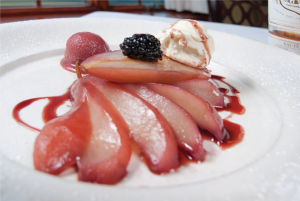 Mosaico. “A mosaic is made up of a thousand little details that are individually beautiful and of high quality,” says Carrera. “The artist assembles them to form a complete picture. We just reassembled some of the pieces.”
Mosaico. “A mosaic is made up of a thousand little details that are individually beautiful and of high quality,” says Carrera. “The artist assembles them to form a complete picture. We just reassembled some of the pieces.”
The menu morphed into what Carrera describes as Northern Italian with a twist, and it’s the twist that has kept the customers coming back. The Mosaico staff noticed that, as times became increasingly uncomfortable, their regulars started asking for familiar “comfort” foods ranging from Bolognese and carbonara dishes to pizza and burgers. So Dinic and Carrera began sneaking these items into the menu, or at least letting diners know that the kitchen could whip up almost anything they wanted, on the spot, made to order. “The economy forced us to become more flexible, more nimble,” says Dinic. “Our customers appreciated that. They always said, ‘We come here because we know it’s always good.’ As long as we could maintain our standards of service, quality and creativity, we felt that we were being true to the original concept.” Mosaico’s 2011 menu still leans heavily toward modern and traditional Northern Italian cuisine.
The signature dish, Veal Mosaico, a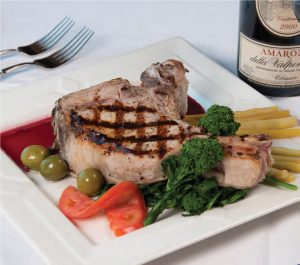 creation of chef Luis Romero (who has been cooking for Carrera and Dinic for more than a decade) is a scallopine layered with portabella mushrooms, roasted peppers and gorgonzola, in a brandy brown sauce, served with red potatoes on a bed of arugula. Another standout item is the French cut grilled pork chop. It has an entirely different thickness than what New Jersey restaurant-goers are probably used to. It’s never dry, even when ordered well done. Mosaico has also carved out a sterling reputation as a place to enjoy the bounty of the ocean. There are always at least two fish specials on the menu, even at lunch. Regulars swear by the crab cakes and, according to Carrera, the seafood salad rivals prosciutto and melon as their most popular appetizer. Grilled calamari is not on the menu, but is listed among the specials almost every day. Fish and shellfish are delivered each morning, so there’s an excellent chance that what comes to the table was swimming somewhere the previous day. The crowd at Mosaico is a mosaic in and of itself. At midday, four out of five tables appear to be business lunches. Some tables tear through their meals, while others linger well
creation of chef Luis Romero (who has been cooking for Carrera and Dinic for more than a decade) is a scallopine layered with portabella mushrooms, roasted peppers and gorgonzola, in a brandy brown sauce, served with red potatoes on a bed of arugula. Another standout item is the French cut grilled pork chop. It has an entirely different thickness than what New Jersey restaurant-goers are probably used to. It’s never dry, even when ordered well done. Mosaico has also carved out a sterling reputation as a place to enjoy the bounty of the ocean. There are always at least two fish specials on the menu, even at lunch. Regulars swear by the crab cakes and, according to Carrera, the seafood salad rivals prosciutto and melon as their most popular appetizer. Grilled calamari is not on the menu, but is listed among the specials almost every day. Fish and shellfish are delivered each morning, so there’s an excellent chance that what comes to the table was swimming somewhere the previous day. The crowd at Mosaico is a mosaic in and of itself. At midday, four out of five tables appear to be business lunches. Some tables tear through their meals, while others linger well 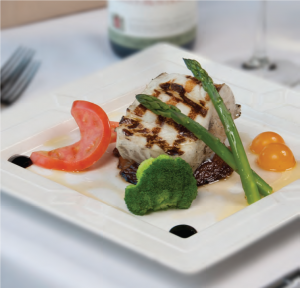 into the afternoon. In the evenings, it’s a blend of young and old, family dinners and romantic twosomes, and a fair number of business people.
into the afternoon. In the evenings, it’s a blend of young and old, family dinners and romantic twosomes, and a fair number of business people.
The restaurant is also a popular spot for private parties. According to Dinic, that is how many people discover Mosaico. He also estimates that, at any given time, about 40 percent of the faces that come through the door are familiar ones. In an era where customer loyalty is key, that is a very healthy number. The look of Mosaico is best described as a blend of modern and traditional. High ceilings in the dining room create a feel of openness and cut down on the noise, and there is a cozy lounge area that makes waiting for tables a very civilized experience. Mosaics fashioned from antique tiles that once graced buildings in Italy serve to soften the decor and add color—and also inspired the restaurant’s name. Indeed, at first the two owners could not agree on a name. It was their interior designer who suggested Mosaico.
Ultimately, what people appreciate most about Mosaico is not what’s inside the walls, but what’s inside the people who work there. From the owners to the kitchen and wait staff— right down to the busboys—there is a genuine feeling of family. And that feeling is extended to the people who patronize Mosaico. Carrera says that he and Dinic work hard every day to keep their employees focused on the experience they deliver to customers—and to treat them the way they would like to be treated if they were sitting down to a great meal. “As much as the quality and consistency of the food, it’s the personal attention and service that defines Mosaico,” says Dinic. “When you’re here you really feel like you’re at home,” adds Carrera. “Only the food is better and you don’t get stuck doing the dishes.”








Gourmet Food Trucks Go Full Throttle
Early morning. My friend, Pam, jumps off the ferry at Pier 17. As she scoots up Wall Street, she stops at a steaming cart to purchase the “best oatmeal in the world.” Next stop is a fresh fruit purveyor for just squeezed orange juice. Then on to another truck to buy “phenomenal” coffee. Breakfast in hand in only three minutes—a lot quicker than the corner diner—she heads up to catch the #6 subway. “I love buying food from these trucks,” she enthuses. Pam is an elegant woman in her 60s with high standards. She enjoys good food and dresses impeccably. So what is she doing ingesting food-on-the-fly (and from the street, no less)? My first reaction: Inoculate me…or at the very least pass the Tongue Purell! But since observing Pam grab food on the run that morning, I’ve noticed that food trucks have become ubiquitous, quite the thing and even chic on both sides of the Hudson. In the immortal words of Jimmy Durante, “Everybody’s getting in on the act.”
In his televised Bobby Flay’s Throwdown!, Iron Chef Bobby Flay has challenged to culinary cook-offs—and lost to—a number of food truck vendors. The New York Times food section regularly mentions these popular gourmet gypsies, and how and where to locate them. Zagats’ blog has launched a Food Truck Finder, providing parking location, reviews and even ratings of dozens of trucks—which is amazing since it didn’t include the popular Rickshaw Dumpling Truck, Kimchi Taco Truck, or King of Falafel. Even Food Network celebrity chef Tyler Florence has joined the movement, hosting The Great Food Truck Race, a culinary road show in which seven food trucks from California to Texas vie to be the most successful and win a $50,000 prize. Street food is older than a Babylonian bazaar. So what is creating this present-day proliferation of mobile food vending businesses? From Portland Oregon (600-plus trucks) to Austin, Texas, (more than 1,000), the mobile food business seems to be gaining momentum. It started on the West Coast (Los Angeles had food trucks as far back as the 1940s) and has headed East. Recently, Newsweek devoted an entire page to a wildly popular taco truck in L.A. Being in-the-know about a new restaurant, art installation or trend feeds the pop-up culture of the 3rd millennium, where businesses come and go in a matter of weeks. Often aided by social networks, a movable feast in a truck has become something for foodies to watch, follow, friend and tweet. Pam, my commuting friend, is no exception. She adores the thrill of discovery and being in on something new, delicious and personal.
KING OF QUEENS Krista, a chic young New Yorker, often grabs her dinner from King of Falafel in Astoria, Queens on the way home from her sales and marketing job. She says the very personal aspect of dining “a la cart” lends added appeal to the experience. “A huge part of what makes it so great are the people,” Krista explains. “There is always a long line of ‘Astorians’ of all ages and ethnicities waiting for the consistently delicious food. It’s fun to listen to the banter and the guys that work the cart are great. Oftentimes they give me some fresh falafel to munch on while I wait for my order of piles of marinated chicken and lots of tahini. And they tend to call me sweetie or sweetheart, which is actually kind of charming coming from them.” Not every food aficionado is on board with the truck trend. Once when the subject was raised, Mimi Sheraton, the former New York Times food critic, demanded to know “where the hell do you eat” the food? How about at the office, on a bench, or whatever conveyance takes you home? Since being inspired by Pam’s culinary trek up Wall Street, I have shared a Rickshaw Truck Hudson Valley Peking duck dumpling with my friend Sugie on the high seas (aka the Seastreak Ferry). I’ve even managed to carry a Dessert Truck sublime chocolate bread pudding all the way home before devouring it.
THE WHEEL DEAL Who are these enterprising mobile food vendors? Culinary school grads find the trucks a low-cost way to start a food following. Whereas opening a restaurant with rent and renovation might cost over $1 million, outfitting a gourmet food truck will cost between $75,000 for a used one and $200,000 for brand spanking new. New Jersey chef Adam Sobel purchased, outfitted and decorated his vegan food “Cinnamon Snail” truck for $26,000—acquiring the
used truck and supplies through Craigslist and paying his artistic and electronically savvy friends with free food. He has since upgraded the truck with $14,000 worth of improvements. Some restaurants wanting to deliver their food brand to other neighborhoods have started fleets of mobile food vendors. Rickshaw Dumpling, with a brick and mortar restaurant on West 23rd Street in New York, recently added another truck to service its curbside fans. On the other hand, some trucks—Dessert Truck and Cupcake Stop to name a couple—have actually engendered flagship restaurants. So you’re thinking of running a food truck? Thinking it might be fun, cheap and easy? Not so fast. In addition to the sometimes 90-hour-a-week time commitment, roadblocks and speed bumps include municipal bureaucracies with hard-to-obtain permits and licenses, monthly health inspections and police harassment. Also, strict and biased parking restrictions—such as parking too close to a crosswalk—can plague an enterprising food truck operator. As a result, the Street Vendor Project, an unofficial union of vendors, was formed as part of the Urban Justice Center in New York. To raise money to advocate for all street vendors, they initiated the Vendy awards, which Mario Batali calls “the Oscars for food for the real New York.”
JERSEY DRIVERS Gourmet trucks have started pulling into towns across New Jersey, too. However in many places restrictive ordinances can discourage the mobile food business. Sobel, a native of Red Bank, with a kitchen there, spent endless hours earlier this year trying to convince borough officials to carve out a spot where he (and others) could sell food near his home. During the warm-weather months, his Cinnamon Snail has a home every Sunday at the Red Bank Farmer’s Market. Jersey City and Hoboken are home to a number of trucks offering interesting fare. The aforementioned Cinnamon Snail, Two Pitas in a Pod, and the Taco Truck are among the more popular. In the highly competitive food business, one might surmise there is cutthroat competition or turf wars, but in fact there exists camaraderie and mutual respect among the mobile vendors. Indeed, they often swap meals for variety and friendship. Lev Ekster, the Cupcake Stop truck entrepreneur, opted out of law, hired some great bakers and started the first mobile cupcake shoppe. In less than two years, his cupcakes won the Food Network’s Food Feud for Best Cupcake. With a bakery in Montclair, a newly opened shop in Greenwich Village and a truck that ventures into Manhattan each day, Ekster seems to have all the bases covered. If you work in the city, you can even preorder cupcakes for the office and pick them up at his Twittered location. How tweet it is.

